Micro Environment - Assignment
VerifiedAdded on 2021/01/19
|28
|7443
|159
AI Summary
Contribute Materials
Your contribution can guide someone’s learning journey. Share your
documents today.
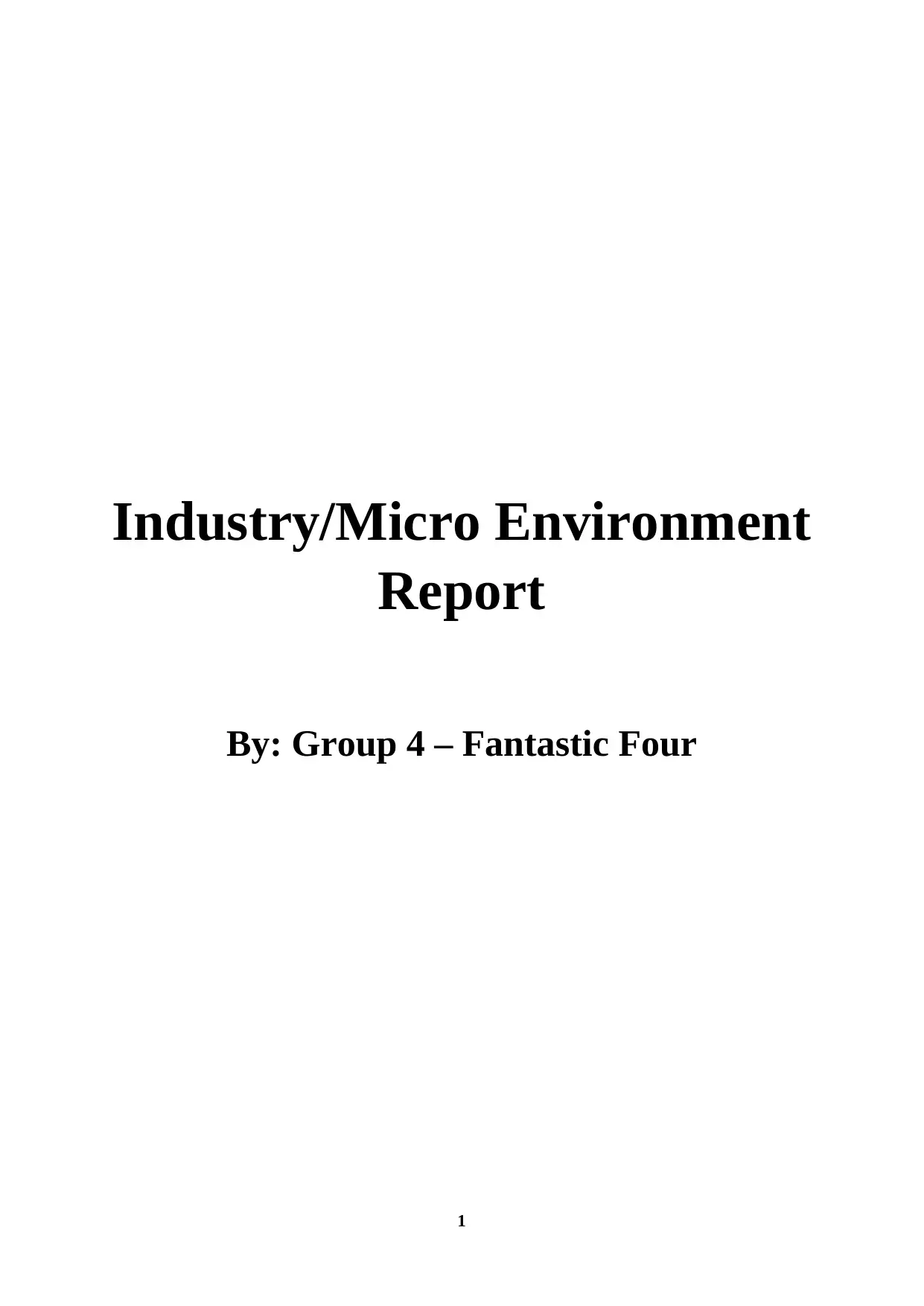
1
Industry/Micro Environment
Report
By: Group 4 – Fantastic Four
Industry/Micro Environment
Report
By: Group 4 – Fantastic Four
Secure Best Marks with AI Grader
Need help grading? Try our AI Grader for instant feedback on your assignments.
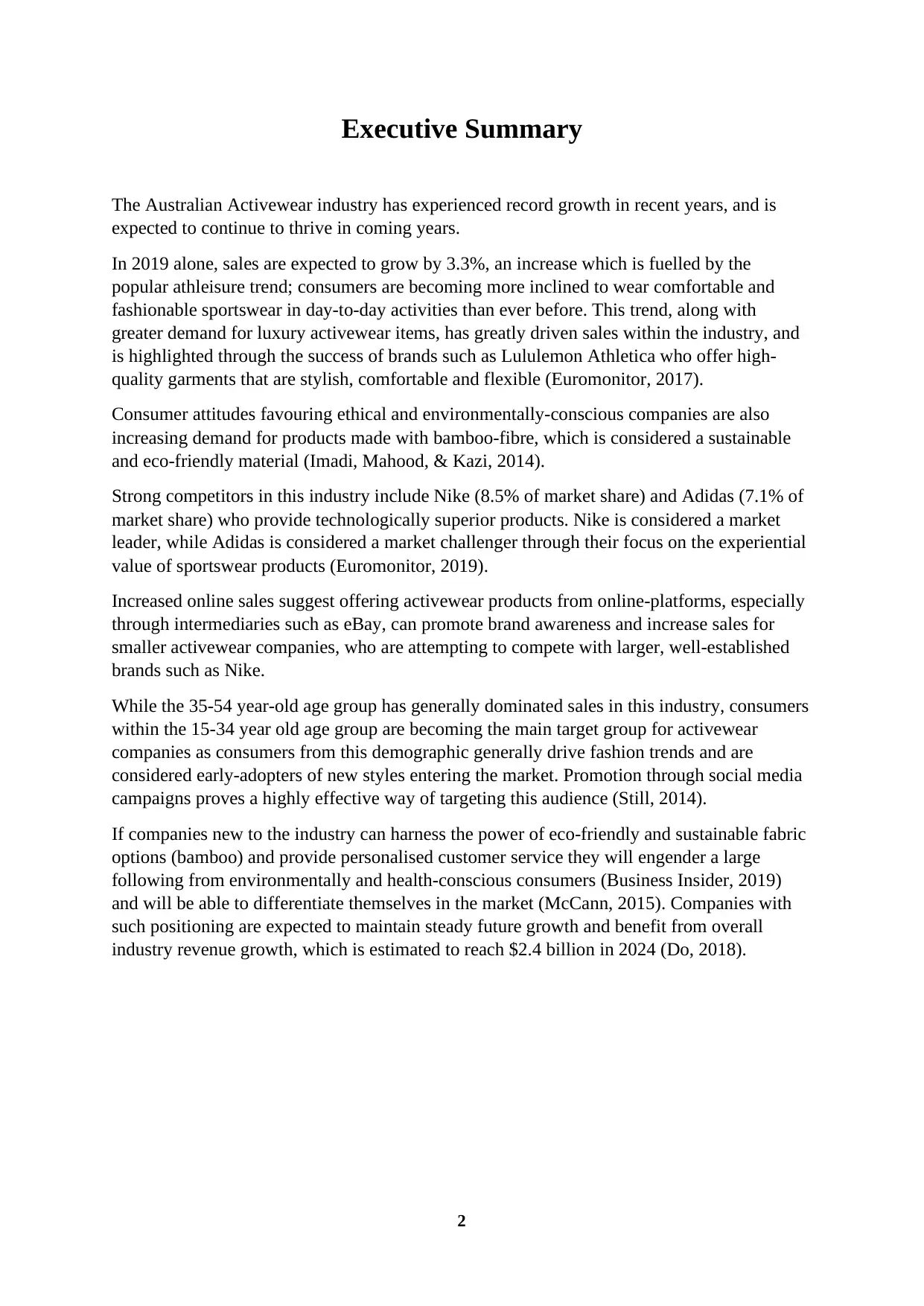
2
Executive Summary
The Australian Activewear industry has experienced record growth in recent years, and is
expected to continue to thrive in coming years.
In 2019 alone, sales are expected to grow by 3.3%, an increase which is fuelled by the
popular athleisure trend; consumers are becoming more inclined to wear comfortable and
fashionable sportswear in day-to-day activities than ever before. This trend, along with
greater demand for luxury activewear items, has greatly driven sales within the industry, and
is highlighted through the success of brands such as Lululemon Athletica who offer high-
quality garments that are stylish, comfortable and flexible (Euromonitor, 2017).
Consumer attitudes favouring ethical and environmentally-conscious companies are also
increasing demand for products made with bamboo-fibre, which is considered a sustainable
and eco-friendly material (Imadi, Mahood, & Kazi, 2014).
Strong competitors in this industry include Nike (8.5% of market share) and Adidas (7.1% of
market share) who provide technologically superior products. Nike is considered a market
leader, while Adidas is considered a market challenger through their focus on the experiential
value of sportswear products (Euromonitor, 2019).
Increased online sales suggest offering activewear products from online-platforms, especially
through intermediaries such as eBay, can promote brand awareness and increase sales for
smaller activewear companies, who are attempting to compete with larger, well-established
brands such as Nike.
While the 35-54 year-old age group has generally dominated sales in this industry, consumers
within the 15-34 year old age group are becoming the main target group for activewear
companies as consumers from this demographic generally drive fashion trends and are
considered early-adopters of new styles entering the market. Promotion through social media
campaigns proves a highly effective way of targeting this audience (Still, 2014).
If companies new to the industry can harness the power of eco-friendly and sustainable fabric
options (bamboo) and provide personalised customer service they will engender a large
following from environmentally and health-conscious consumers (Business Insider, 2019)
and will be able to differentiate themselves in the market (McCann, 2015). Companies with
such positioning are expected to maintain steady future growth and benefit from overall
industry revenue growth, which is estimated to reach $2.4 billion in 2024 (Do, 2018).
Executive Summary
The Australian Activewear industry has experienced record growth in recent years, and is
expected to continue to thrive in coming years.
In 2019 alone, sales are expected to grow by 3.3%, an increase which is fuelled by the
popular athleisure trend; consumers are becoming more inclined to wear comfortable and
fashionable sportswear in day-to-day activities than ever before. This trend, along with
greater demand for luxury activewear items, has greatly driven sales within the industry, and
is highlighted through the success of brands such as Lululemon Athletica who offer high-
quality garments that are stylish, comfortable and flexible (Euromonitor, 2017).
Consumer attitudes favouring ethical and environmentally-conscious companies are also
increasing demand for products made with bamboo-fibre, which is considered a sustainable
and eco-friendly material (Imadi, Mahood, & Kazi, 2014).
Strong competitors in this industry include Nike (8.5% of market share) and Adidas (7.1% of
market share) who provide technologically superior products. Nike is considered a market
leader, while Adidas is considered a market challenger through their focus on the experiential
value of sportswear products (Euromonitor, 2019).
Increased online sales suggest offering activewear products from online-platforms, especially
through intermediaries such as eBay, can promote brand awareness and increase sales for
smaller activewear companies, who are attempting to compete with larger, well-established
brands such as Nike.
While the 35-54 year-old age group has generally dominated sales in this industry, consumers
within the 15-34 year old age group are becoming the main target group for activewear
companies as consumers from this demographic generally drive fashion trends and are
considered early-adopters of new styles entering the market. Promotion through social media
campaigns proves a highly effective way of targeting this audience (Still, 2014).
If companies new to the industry can harness the power of eco-friendly and sustainable fabric
options (bamboo) and provide personalised customer service they will engender a large
following from environmentally and health-conscious consumers (Business Insider, 2019)
and will be able to differentiate themselves in the market (McCann, 2015). Companies with
such positioning are expected to maintain steady future growth and benefit from overall
industry revenue growth, which is estimated to reach $2.4 billion in 2024 (Do, 2018).
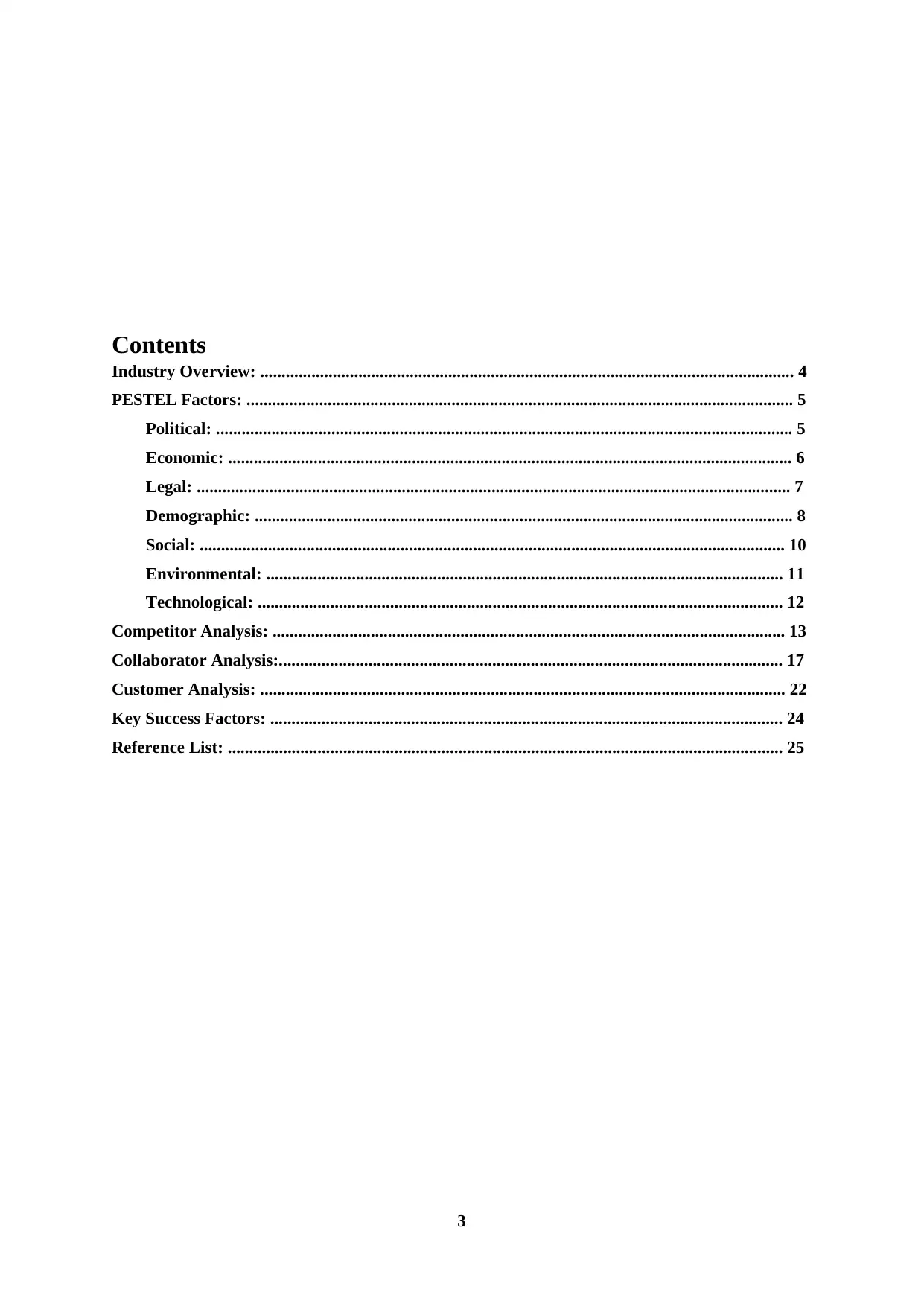
3
Contents
Industry Overview: ............................................................................................................................. 4
PESTEL Factors: ................................................................................................................................ 5
Political: ....................................................................................................................................... 5
Economic: .................................................................................................................................... 6
Legal: ........................................................................................................................................... 7
Demographic: .............................................................................................................................. 8
Social: ......................................................................................................................................... 10
Environmental: ......................................................................................................................... 11
Technological: ........................................................................................................................... 12
Competitor Analysis: ........................................................................................................................ 13
Collaborator Analysis:...................................................................................................................... 17
Customer Analysis: ........................................................................................................................... 22
Key Success Factors: ........................................................................................................................ 24
Reference List: .................................................................................................................................. 25
Contents
Industry Overview: ............................................................................................................................. 4
PESTEL Factors: ................................................................................................................................ 5
Political: ....................................................................................................................................... 5
Economic: .................................................................................................................................... 6
Legal: ........................................................................................................................................... 7
Demographic: .............................................................................................................................. 8
Social: ......................................................................................................................................... 10
Environmental: ......................................................................................................................... 11
Technological: ........................................................................................................................... 12
Competitor Analysis: ........................................................................................................................ 13
Collaborator Analysis:...................................................................................................................... 17
Customer Analysis: ........................................................................................................................... 22
Key Success Factors: ........................................................................................................................ 24
Reference List: .................................................................................................................................. 25
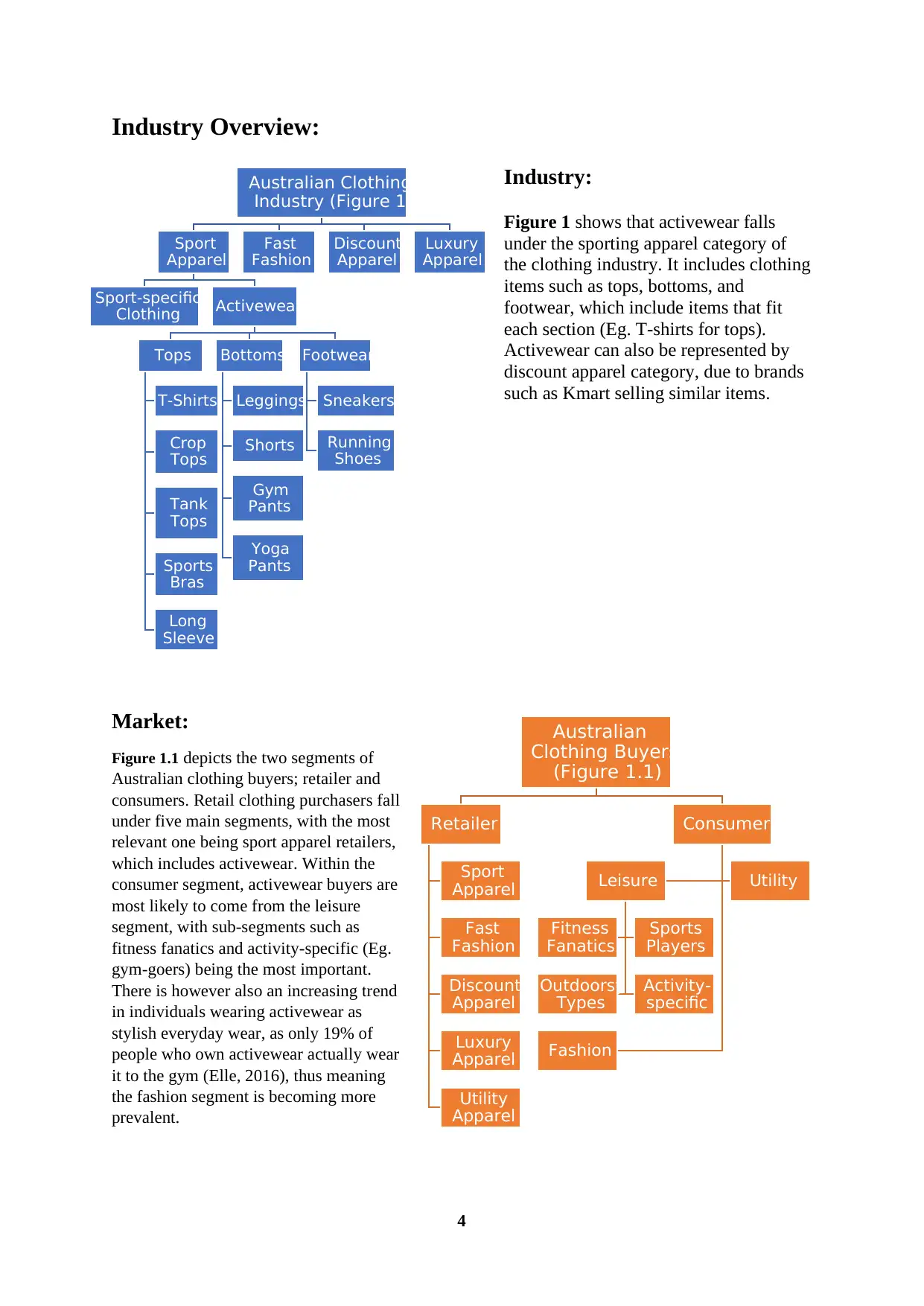
4
Industry Overview:
Industry:
Figure 1 shows that activewear falls
under the sporting apparel category of
the clothing industry. It includes clothing
items such as tops, bottoms, and
footwear, which include items that fit
each section (Eg. T-shirts for tops).
Activewear can also be represented by
discount apparel category, due to brands
such as Kmart selling similar items.
Market:
Figure 1.1 depicts the two segments of
Australian clothing buyers; retailer and
consumers. Retail clothing purchasers fall
under five main segments, with the most
relevant one being sport apparel retailers,
which includes activewear. Within the
consumer segment, activewear buyers are
most likely to come from the leisure
segment, with sub-segments such as
fitness fanatics and activity-specific (Eg.
gym-goers) being the most important.
There is however also an increasing trend
in individuals wearing activewear as
stylish everyday wear, as only 19% of
people who own activewear actually wear
it to the gym (Elle, 2016), thus meaning
the fashion segment is becoming more
prevalent.
Australian Clothing
Industry (Figure 1)
Sport
Apparel
Sport-specific
Clothing Activewear
Tops
T-Shirts
Crop
Tops
Tank
Tops
Sports
Bras
Long
Sleeve
Bottoms
Leggings
Shorts
Gym
Pants
Yoga
Pants
Footwear
Sneakers
Running
Shoes
Fast
Fashion
Discount
Apparel
Luxury
Apparel
Australian
Clothing Buyers
(Figure 1.1)
Retailer
Sport
Apparel
Fast
Fashion
Discount
Apparel
Luxury
Apparel
Utility
Apparel
Consumer
Leisure
Fitness
Fanatics
Sports
Players
Outdoorsy
Types
Activity-
specific
Utility
Fashion
Industry Overview:
Industry:
Figure 1 shows that activewear falls
under the sporting apparel category of
the clothing industry. It includes clothing
items such as tops, bottoms, and
footwear, which include items that fit
each section (Eg. T-shirts for tops).
Activewear can also be represented by
discount apparel category, due to brands
such as Kmart selling similar items.
Market:
Figure 1.1 depicts the two segments of
Australian clothing buyers; retailer and
consumers. Retail clothing purchasers fall
under five main segments, with the most
relevant one being sport apparel retailers,
which includes activewear. Within the
consumer segment, activewear buyers are
most likely to come from the leisure
segment, with sub-segments such as
fitness fanatics and activity-specific (Eg.
gym-goers) being the most important.
There is however also an increasing trend
in individuals wearing activewear as
stylish everyday wear, as only 19% of
people who own activewear actually wear
it to the gym (Elle, 2016), thus meaning
the fashion segment is becoming more
prevalent.
Australian Clothing
Industry (Figure 1)
Sport
Apparel
Sport-specific
Clothing Activewear
Tops
T-Shirts
Crop
Tops
Tank
Tops
Sports
Bras
Long
Sleeve
Bottoms
Leggings
Shorts
Gym
Pants
Yoga
Pants
Footwear
Sneakers
Running
Shoes
Fast
Fashion
Discount
Apparel
Luxury
Apparel
Australian
Clothing Buyers
(Figure 1.1)
Retailer
Sport
Apparel
Fast
Fashion
Discount
Apparel
Luxury
Apparel
Utility
Apparel
Consumer
Leisure
Fitness
Fanatics
Sports
Players
Outdoorsy
Types
Activity-
specific
Utility
Fashion
Secure Best Marks with AI Grader
Need help grading? Try our AI Grader for instant feedback on your assignments.
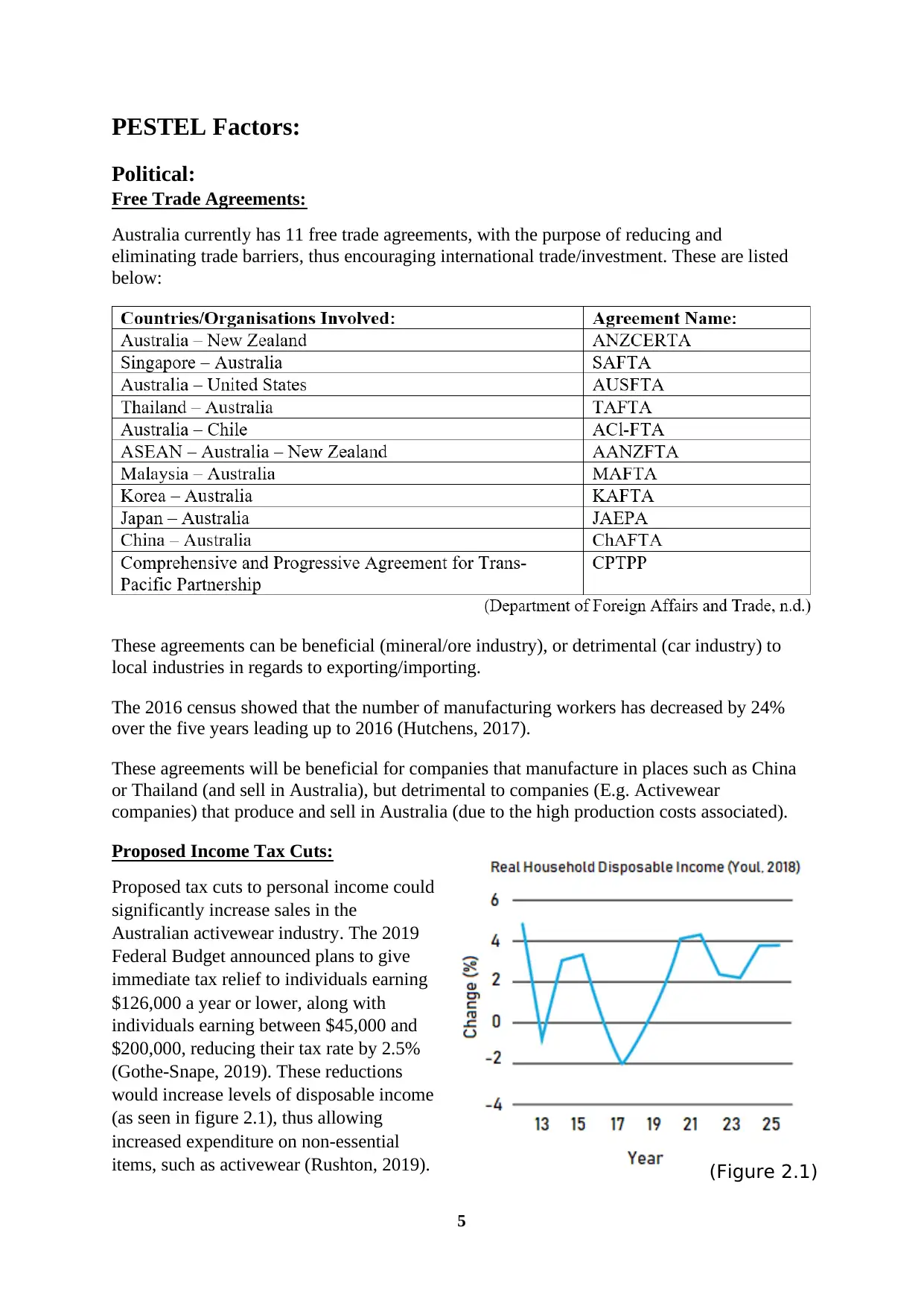
5
PESTEL Factors:
Political:
Free Trade Agreements:
Australia currently has 11 free trade agreements, with the purpose of reducing and
eliminating trade barriers, thus encouraging international trade/investment. These are listed
below:
These agreements can be beneficial (mineral/ore industry), or detrimental (car industry) to
local industries in regards to exporting/importing.
The 2016 census showed that the number of manufacturing workers has decreased by 24%
over the five years leading up to 2016 (Hutchens, 2017).
These agreements will be beneficial for companies that manufacture in places such as China
or Thailand (and sell in Australia), but detrimental to companies (E.g. Activewear
companies) that produce and sell in Australia (due to the high production costs associated).
Proposed Income Tax Cuts:
Proposed tax cuts to personal income could
significantly increase sales in the
Australian activewear industry. The 2019
Federal Budget announced plans to give
immediate tax relief to individuals earning
$126,000 a year or lower, along with
individuals earning between $45,000 and
$200,000, reducing their tax rate by 2.5%
(Gothe-Snape, 2019). These reductions
would increase levels of disposable income
(as seen in figure 2.1), thus allowing
increased expenditure on non-essential
items, such as activewear (Rushton, 2019). (Figure 2.1)
PESTEL Factors:
Political:
Free Trade Agreements:
Australia currently has 11 free trade agreements, with the purpose of reducing and
eliminating trade barriers, thus encouraging international trade/investment. These are listed
below:
These agreements can be beneficial (mineral/ore industry), or detrimental (car industry) to
local industries in regards to exporting/importing.
The 2016 census showed that the number of manufacturing workers has decreased by 24%
over the five years leading up to 2016 (Hutchens, 2017).
These agreements will be beneficial for companies that manufacture in places such as China
or Thailand (and sell in Australia), but detrimental to companies (E.g. Activewear
companies) that produce and sell in Australia (due to the high production costs associated).
Proposed Income Tax Cuts:
Proposed tax cuts to personal income could
significantly increase sales in the
Australian activewear industry. The 2019
Federal Budget announced plans to give
immediate tax relief to individuals earning
$126,000 a year or lower, along with
individuals earning between $45,000 and
$200,000, reducing their tax rate by 2.5%
(Gothe-Snape, 2019). These reductions
would increase levels of disposable income
(as seen in figure 2.1), thus allowing
increased expenditure on non-essential
items, such as activewear (Rushton, 2019). (Figure 2.1)
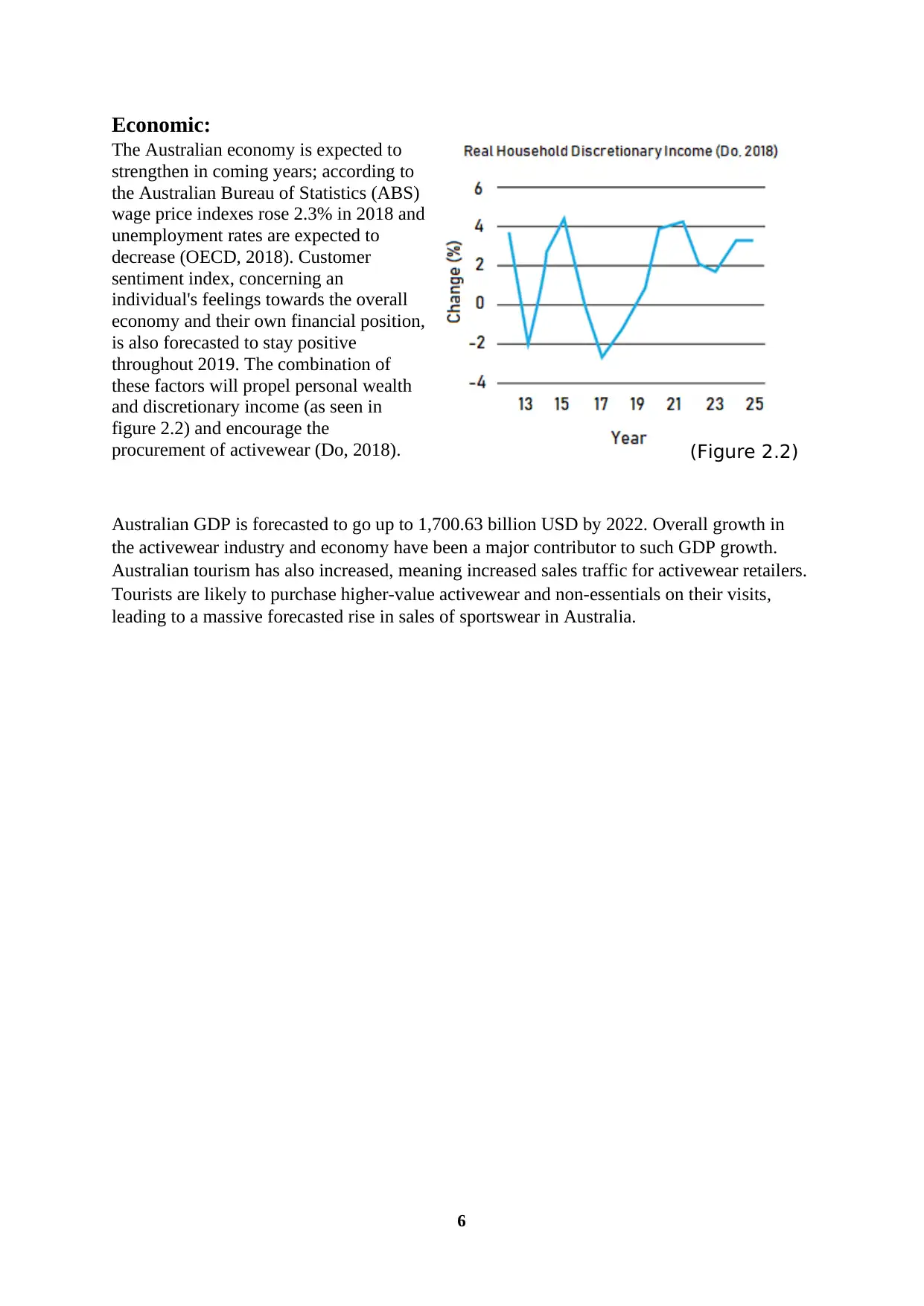
6
Economic:
The Australian economy is expected to
strengthen in coming years; according to
the Australian Bureau of Statistics (ABS)
wage price indexes rose 2.3% in 2018 and
unemployment rates are expected to
decrease (OECD, 2018). Customer
sentiment index, concerning an
individual's feelings towards the overall
economy and their own financial position,
is also forecasted to stay positive
throughout 2019. The combination of
these factors will propel personal wealth
and discretionary income (as seen in
figure 2.2) and encourage the
procurement of activewear (Do, 2018).
Australian GDP is forecasted to go up to 1,700.63 billion USD by 2022. Overall growth in
the activewear industry and economy have been a major contributor to such GDP growth.
Australian tourism has also increased, meaning increased sales traffic for activewear retailers.
Tourists are likely to purchase higher-value activewear and non-essentials on their visits,
leading to a massive forecasted rise in sales of sportswear in Australia.
(Figure 2.2)
Economic:
The Australian economy is expected to
strengthen in coming years; according to
the Australian Bureau of Statistics (ABS)
wage price indexes rose 2.3% in 2018 and
unemployment rates are expected to
decrease (OECD, 2018). Customer
sentiment index, concerning an
individual's feelings towards the overall
economy and their own financial position,
is also forecasted to stay positive
throughout 2019. The combination of
these factors will propel personal wealth
and discretionary income (as seen in
figure 2.2) and encourage the
procurement of activewear (Do, 2018).
Australian GDP is forecasted to go up to 1,700.63 billion USD by 2022. Overall growth in
the activewear industry and economy have been a major contributor to such GDP growth.
Australian tourism has also increased, meaning increased sales traffic for activewear retailers.
Tourists are likely to purchase higher-value activewear and non-essentials on their visits,
leading to a massive forecasted rise in sales of sportswear in Australia.
(Figure 2.2)
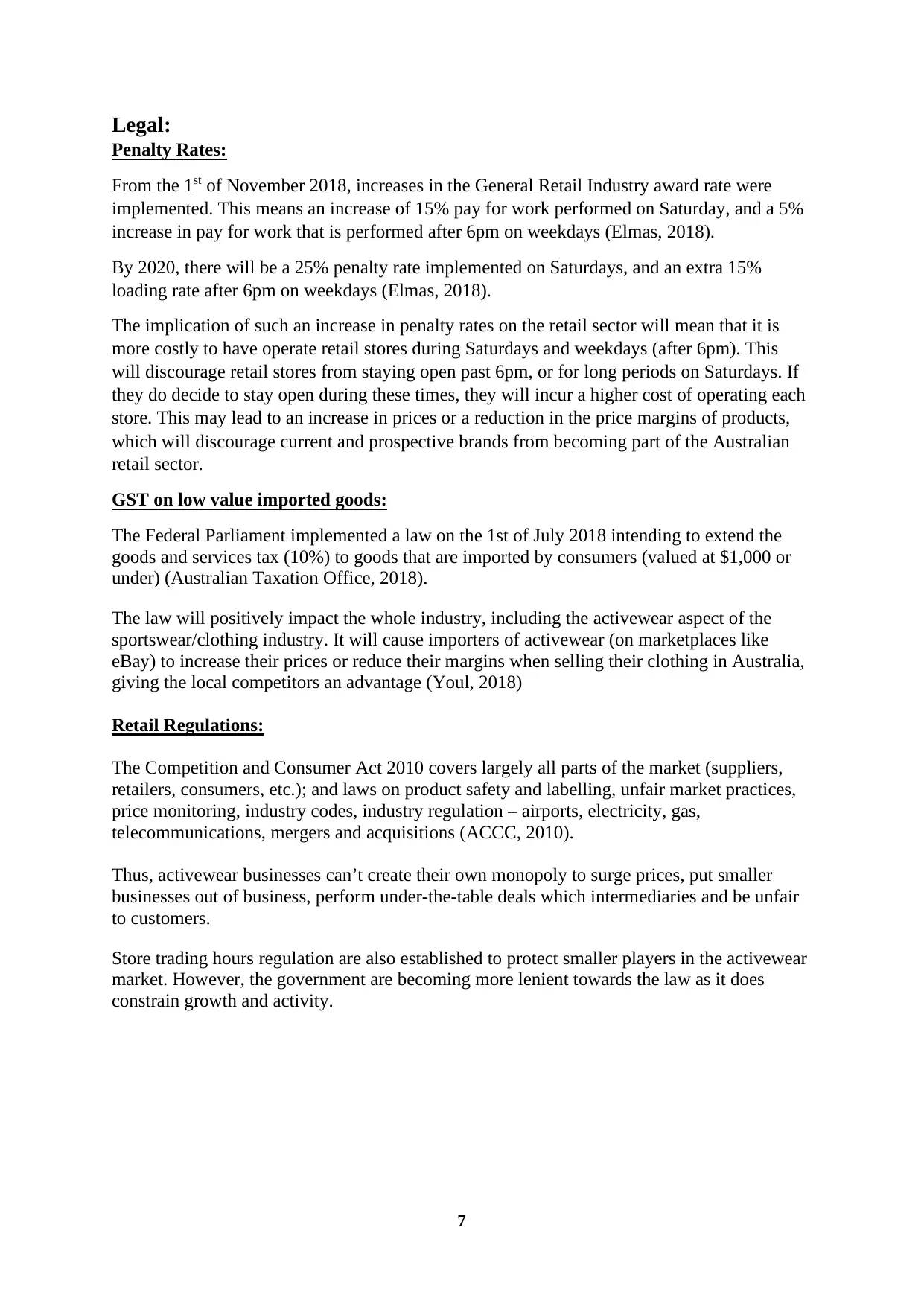
7
Legal:
Penalty Rates:
From the 1st of November 2018, increases in the General Retail Industry award rate were
implemented. This means an increase of 15% pay for work performed on Saturday, and a 5%
increase in pay for work that is performed after 6pm on weekdays (Elmas, 2018).
By 2020, there will be a 25% penalty rate implemented on Saturdays, and an extra 15%
loading rate after 6pm on weekdays (Elmas, 2018).
The implication of such an increase in penalty rates on the retail sector will mean that it is
more costly to have operate retail stores during Saturdays and weekdays (after 6pm). This
will discourage retail stores from staying open past 6pm, or for long periods on Saturdays. If
they do decide to stay open during these times, they will incur a higher cost of operating each
store. This may lead to an increase in prices or a reduction in the price margins of products,
which will discourage current and prospective brands from becoming part of the Australian
retail sector.
GST on low value imported goods:
The Federal Parliament implemented a law on the 1st of July 2018 intending to extend the
goods and services tax (10%) to goods that are imported by consumers (valued at $1,000 or
under) (Australian Taxation Office, 2018).
The law will positively impact the whole industry, including the activewear aspect of the
sportswear/clothing industry. It will cause importers of activewear (on marketplaces like
eBay) to increase their prices or reduce their margins when selling their clothing in Australia,
giving the local competitors an advantage (Youl, 2018)
Retail Regulations:
The Competition and Consumer Act 2010 covers largely all parts of the market (suppliers,
retailers, consumers, etc.); and laws on product safety and labelling, unfair market practices,
price monitoring, industry codes, industry regulation – airports, electricity, gas,
telecommunications, mergers and acquisitions (ACCC, 2010).
Thus, activewear businesses can’t create their own monopoly to surge prices, put smaller
businesses out of business, perform under-the-table deals which intermediaries and be unfair
to customers.
Store trading hours regulation are also established to protect smaller players in the activewear
market. However, the government are becoming more lenient towards the law as it does
constrain growth and activity.
Legal:
Penalty Rates:
From the 1st of November 2018, increases in the General Retail Industry award rate were
implemented. This means an increase of 15% pay for work performed on Saturday, and a 5%
increase in pay for work that is performed after 6pm on weekdays (Elmas, 2018).
By 2020, there will be a 25% penalty rate implemented on Saturdays, and an extra 15%
loading rate after 6pm on weekdays (Elmas, 2018).
The implication of such an increase in penalty rates on the retail sector will mean that it is
more costly to have operate retail stores during Saturdays and weekdays (after 6pm). This
will discourage retail stores from staying open past 6pm, or for long periods on Saturdays. If
they do decide to stay open during these times, they will incur a higher cost of operating each
store. This may lead to an increase in prices or a reduction in the price margins of products,
which will discourage current and prospective brands from becoming part of the Australian
retail sector.
GST on low value imported goods:
The Federal Parliament implemented a law on the 1st of July 2018 intending to extend the
goods and services tax (10%) to goods that are imported by consumers (valued at $1,000 or
under) (Australian Taxation Office, 2018).
The law will positively impact the whole industry, including the activewear aspect of the
sportswear/clothing industry. It will cause importers of activewear (on marketplaces like
eBay) to increase their prices or reduce their margins when selling their clothing in Australia,
giving the local competitors an advantage (Youl, 2018)
Retail Regulations:
The Competition and Consumer Act 2010 covers largely all parts of the market (suppliers,
retailers, consumers, etc.); and laws on product safety and labelling, unfair market practices,
price monitoring, industry codes, industry regulation – airports, electricity, gas,
telecommunications, mergers and acquisitions (ACCC, 2010).
Thus, activewear businesses can’t create their own monopoly to surge prices, put smaller
businesses out of business, perform under-the-table deals which intermediaries and be unfair
to customers.
Store trading hours regulation are also established to protect smaller players in the activewear
market. However, the government are becoming more lenient towards the law as it does
constrain growth and activity.
Paraphrase This Document
Need a fresh take? Get an instant paraphrase of this document with our AI Paraphraser

8
Demographic:
The Australian
activewear market
(retail) can be
broken down into
three segments; the
largest being
consumers in the
35-54 year-old age
bracket occupying
46.3% of the
market (Do, 2018).
The largest of the
segments (age)
within the online
sporting apparel
market is similar to
the retail market,
with 49.8% of
consumers being
between the ages
of 35 and 54
(Youl, 2018)
The 2016 Australian census
shows us that the age group of
35-54 consists of 26.8% of
Australians, and the age group
15-34 consists of 27.2%. People
aged 55 and over consist of
27.6%, meaning that all three
age groups consist of a similar
amount of people (.id, 2016)
Age 55+,
17.10%
Age 35-54,
46.30%
Age 15-34,
36.60%
Age Range of Market for Fitness and Athletic Clothing
Retail Stores (2018-19)(Do, 2018) (Figure 2.3)
Age 55+,
11.10%
Age 35-54,
49.80%
Age 15-34,
39.10%
Age Range of Market for Online Sporting Apparel
(2018-19)(Youl, 2018) (Figure 2.4)
Age 15-34,
27.20%
Age 35-54,
26.80%
Age 55+,
27.60%
Age Groups as Percentage of Total
Australian Population (2016 census)
(.id, 2016) (Figure 2.5)
Demographic:
The Australian
activewear market
(retail) can be
broken down into
three segments; the
largest being
consumers in the
35-54 year-old age
bracket occupying
46.3% of the
market (Do, 2018).
The largest of the
segments (age)
within the online
sporting apparel
market is similar to
the retail market,
with 49.8% of
consumers being
between the ages
of 35 and 54
(Youl, 2018)
The 2016 Australian census
shows us that the age group of
35-54 consists of 26.8% of
Australians, and the age group
15-34 consists of 27.2%. People
aged 55 and over consist of
27.6%, meaning that all three
age groups consist of a similar
amount of people (.id, 2016)
Age 55+,
17.10%
Age 35-54,
46.30%
Age 15-34,
36.60%
Age Range of Market for Fitness and Athletic Clothing
Retail Stores (2018-19)(Do, 2018) (Figure 2.3)
Age 55+,
11.10%
Age 35-54,
49.80%
Age 15-34,
39.10%
Age Range of Market for Online Sporting Apparel
(2018-19)(Youl, 2018) (Figure 2.4)
Age 15-34,
27.20%
Age 35-54,
26.80%
Age 55+,
27.60%
Age Groups as Percentage of Total
Australian Population (2016 census)
(.id, 2016) (Figure 2.5)
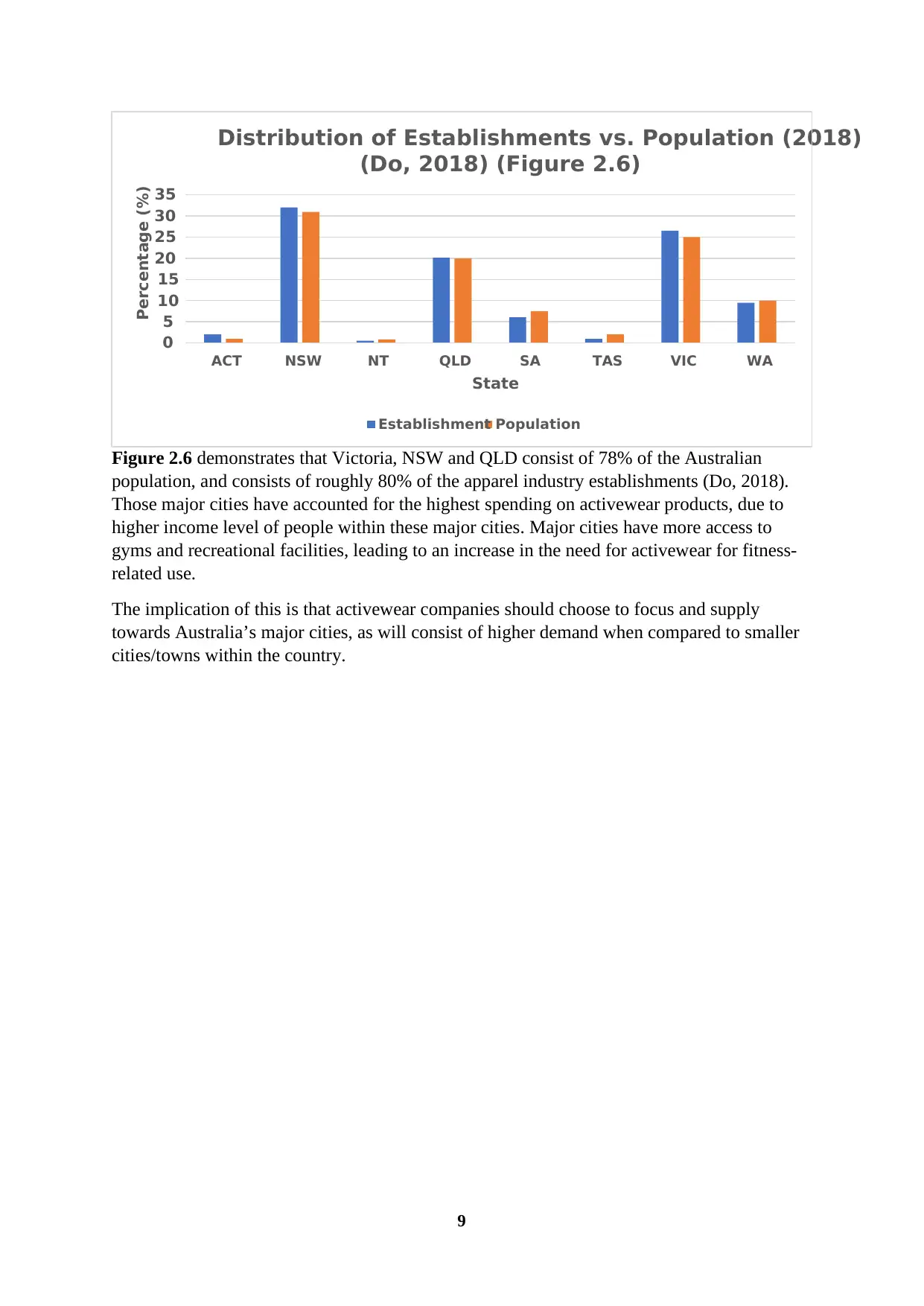
9
Figure 2.6 demonstrates that Victoria, NSW and QLD consist of 78% of the Australian
population, and consists of roughly 80% of the apparel industry establishments (Do, 2018).
Those major cities have accounted for the highest spending on activewear products, due to
higher income level of people within these major cities. Major cities have more access to
gyms and recreational facilities, leading to an increase in the need for activewear for fitness-
related use.
The implication of this is that activewear companies should choose to focus and supply
towards Australia’s major cities, as will consist of higher demand when compared to smaller
cities/towns within the country.
0
5
10
15
20
25
30
35
ACT NSW NT QLD SA TAS VIC WA
Percentage (%)
State
Distribution of Establishments vs. Population (2018)
(Do, 2018) (Figure 2.6)
Establishment Population
Figure 2.6 demonstrates that Victoria, NSW and QLD consist of 78% of the Australian
population, and consists of roughly 80% of the apparel industry establishments (Do, 2018).
Those major cities have accounted for the highest spending on activewear products, due to
higher income level of people within these major cities. Major cities have more access to
gyms and recreational facilities, leading to an increase in the need for activewear for fitness-
related use.
The implication of this is that activewear companies should choose to focus and supply
towards Australia’s major cities, as will consist of higher demand when compared to smaller
cities/towns within the country.
0
5
10
15
20
25
30
35
ACT NSW NT QLD SA TAS VIC WA
Percentage (%)
State
Distribution of Establishments vs. Population (2018)
(Do, 2018) (Figure 2.6)
Establishment Population
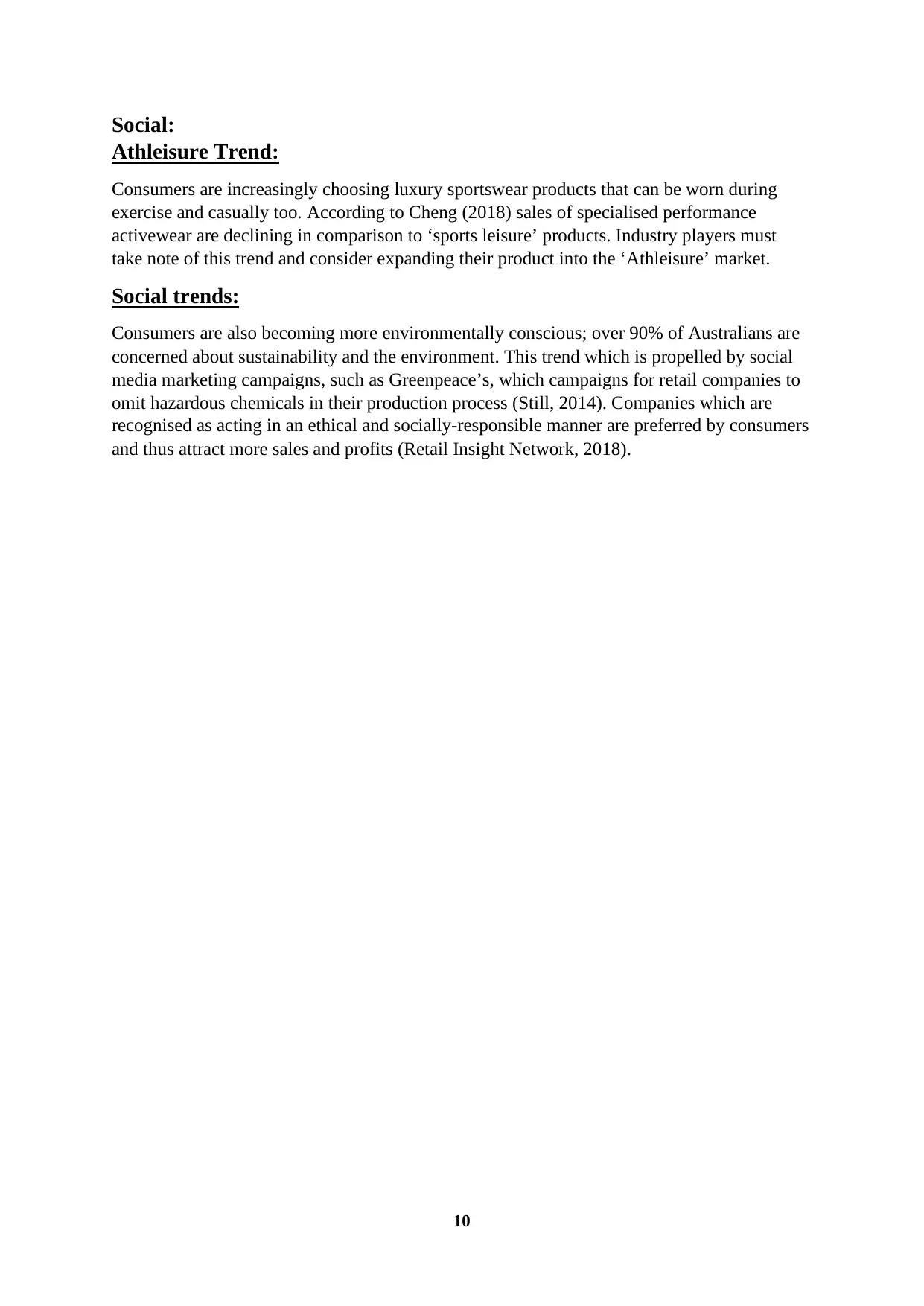
10
Social:
Athleisure Trend:
Consumers are increasingly choosing luxury sportswear products that can be worn during
exercise and casually too. According to Cheng (2018) sales of specialised performance
activewear are declining in comparison to ‘sports leisure’ products. Industry players must
take note of this trend and consider expanding their product into the ‘Athleisure’ market.
Social trends:
Consumers are also becoming more environmentally conscious; over 90% of Australians are
concerned about sustainability and the environment. This trend which is propelled by social
media marketing campaigns, such as Greenpeace’s, which campaigns for retail companies to
omit hazardous chemicals in their production process (Still, 2014). Companies which are
recognised as acting in an ethical and socially-responsible manner are preferred by consumers
and thus attract more sales and profits (Retail Insight Network, 2018).
Social:
Athleisure Trend:
Consumers are increasingly choosing luxury sportswear products that can be worn during
exercise and casually too. According to Cheng (2018) sales of specialised performance
activewear are declining in comparison to ‘sports leisure’ products. Industry players must
take note of this trend and consider expanding their product into the ‘Athleisure’ market.
Social trends:
Consumers are also becoming more environmentally conscious; over 90% of Australians are
concerned about sustainability and the environment. This trend which is propelled by social
media marketing campaigns, such as Greenpeace’s, which campaigns for retail companies to
omit hazardous chemicals in their production process (Still, 2014). Companies which are
recognised as acting in an ethical and socially-responsible manner are preferred by consumers
and thus attract more sales and profits (Retail Insight Network, 2018).
Secure Best Marks with AI Grader
Need help grading? Try our AI Grader for instant feedback on your assignments.
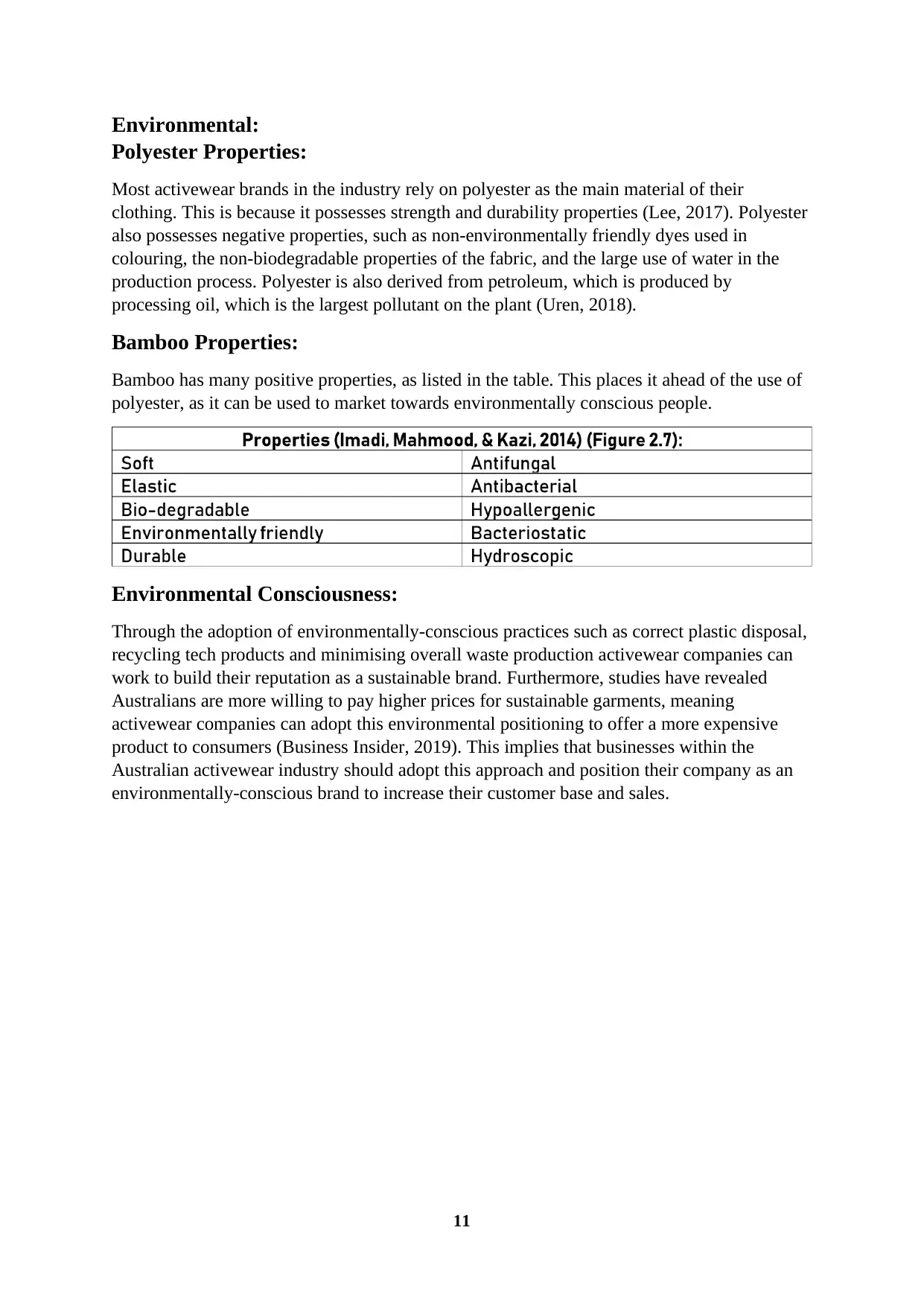
11
Environmental:
Polyester Properties:
Most activewear brands in the industry rely on polyester as the main material of their
clothing. This is because it possesses strength and durability properties (Lee, 2017). Polyester
also possesses negative properties, such as non-environmentally friendly dyes used in
colouring, the non-biodegradable properties of the fabric, and the large use of water in the
production process. Polyester is also derived from petroleum, which is produced by
processing oil, which is the largest pollutant on the plant (Uren, 2018).
Bamboo Properties:
Bamboo has many positive properties, as listed in the table. This places it ahead of the use of
polyester, as it can be used to market towards environmentally conscious people.
Environmental Consciousness:
Through the adoption of environmentally-conscious practices such as correct plastic disposal,
recycling tech products and minimising overall waste production activewear companies can
work to build their reputation as a sustainable brand. Furthermore, studies have revealed
Australians are more willing to pay higher prices for sustainable garments, meaning
activewear companies can adopt this environmental positioning to offer a more expensive
product to consumers (Business Insider, 2019). This implies that businesses within the
Australian activewear industry should adopt this approach and position their company as an
environmentally-conscious brand to increase their customer base and sales.
Environmental:
Polyester Properties:
Most activewear brands in the industry rely on polyester as the main material of their
clothing. This is because it possesses strength and durability properties (Lee, 2017). Polyester
also possesses negative properties, such as non-environmentally friendly dyes used in
colouring, the non-biodegradable properties of the fabric, and the large use of water in the
production process. Polyester is also derived from petroleum, which is produced by
processing oil, which is the largest pollutant on the plant (Uren, 2018).
Bamboo Properties:
Bamboo has many positive properties, as listed in the table. This places it ahead of the use of
polyester, as it can be used to market towards environmentally conscious people.
Environmental Consciousness:
Through the adoption of environmentally-conscious practices such as correct plastic disposal,
recycling tech products and minimising overall waste production activewear companies can
work to build their reputation as a sustainable brand. Furthermore, studies have revealed
Australians are more willing to pay higher prices for sustainable garments, meaning
activewear companies can adopt this environmental positioning to offer a more expensive
product to consumers (Business Insider, 2019). This implies that businesses within the
Australian activewear industry should adopt this approach and position their company as an
environmentally-conscious brand to increase their customer base and sales.
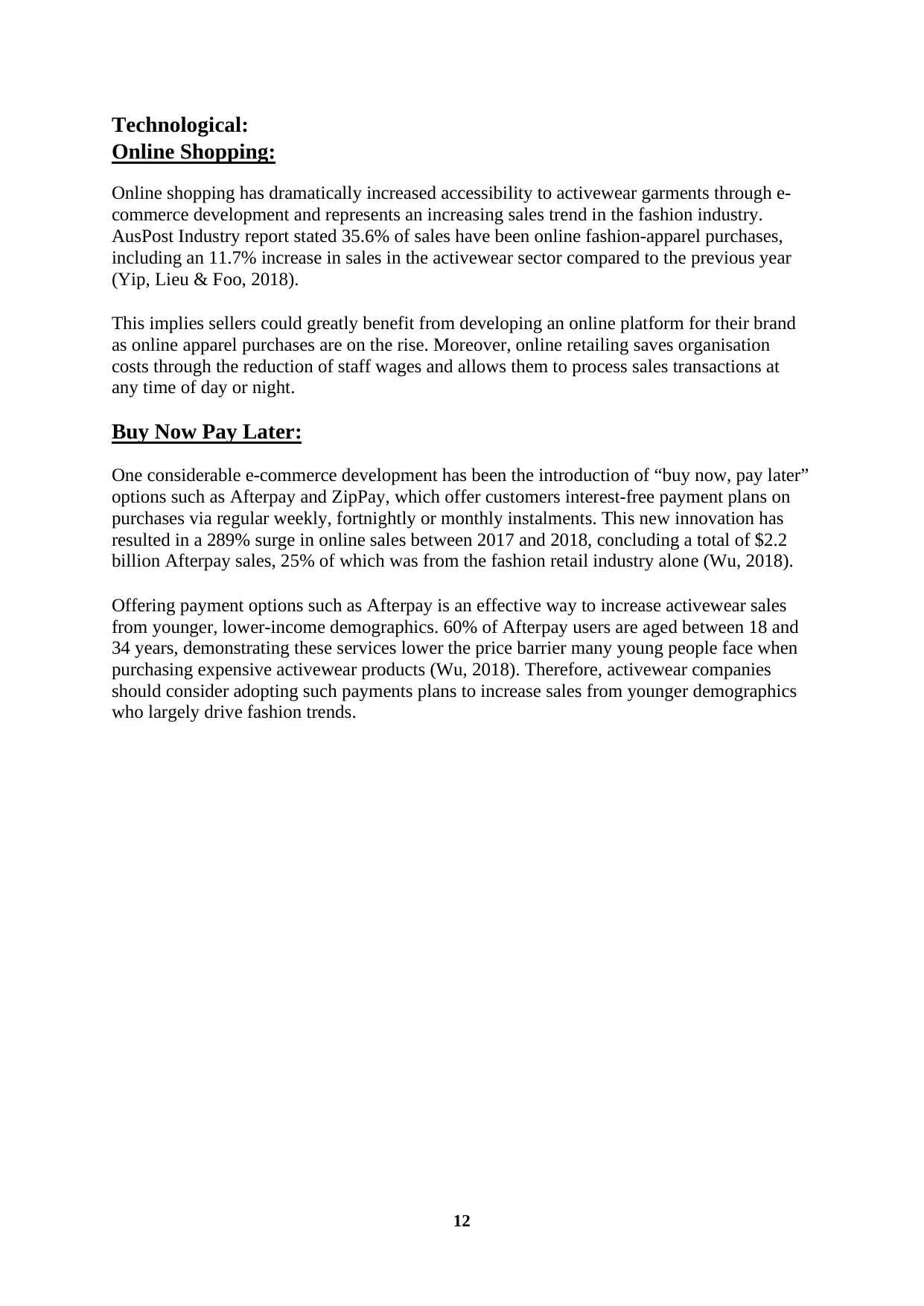
12
Technological:
Online Shopping:
Online shopping has dramatically increased accessibility to activewear garments through e-
commerce development and represents an increasing sales trend in the fashion industry.
AusPost Industry report stated 35.6% of sales have been online fashion-apparel purchases,
including an 11.7% increase in sales in the activewear sector compared to the previous year
(Yip, Lieu & Foo, 2018).
This implies sellers could greatly benefit from developing an online platform for their brand
as online apparel purchases are on the rise. Moreover, online retailing saves organisation
costs through the reduction of staff wages and allows them to process sales transactions at
any time of day or night.
Buy Now Pay Later:
One considerable e-commerce development has been the introduction of “buy now, pay later”
options such as Afterpay and ZipPay, which offer customers interest-free payment plans on
purchases via regular weekly, fortnightly or monthly instalments. This new innovation has
resulted in a 289% surge in online sales between 2017 and 2018, concluding a total of $2.2
billion Afterpay sales, 25% of which was from the fashion retail industry alone (Wu, 2018).
Offering payment options such as Afterpay is an effective way to increase activewear sales
from younger, lower-income demographics. 60% of Afterpay users are aged between 18 and
34 years, demonstrating these services lower the price barrier many young people face when
purchasing expensive activewear products (Wu, 2018). Therefore, activewear companies
should consider adopting such payments plans to increase sales from younger demographics
who largely drive fashion trends.
Technological:
Online Shopping:
Online shopping has dramatically increased accessibility to activewear garments through e-
commerce development and represents an increasing sales trend in the fashion industry.
AusPost Industry report stated 35.6% of sales have been online fashion-apparel purchases,
including an 11.7% increase in sales in the activewear sector compared to the previous year
(Yip, Lieu & Foo, 2018).
This implies sellers could greatly benefit from developing an online platform for their brand
as online apparel purchases are on the rise. Moreover, online retailing saves organisation
costs through the reduction of staff wages and allows them to process sales transactions at
any time of day or night.
Buy Now Pay Later:
One considerable e-commerce development has been the introduction of “buy now, pay later”
options such as Afterpay and ZipPay, which offer customers interest-free payment plans on
purchases via regular weekly, fortnightly or monthly instalments. This new innovation has
resulted in a 289% surge in online sales between 2017 and 2018, concluding a total of $2.2
billion Afterpay sales, 25% of which was from the fashion retail industry alone (Wu, 2018).
Offering payment options such as Afterpay is an effective way to increase activewear sales
from younger, lower-income demographics. 60% of Afterpay users are aged between 18 and
34 years, demonstrating these services lower the price barrier many young people face when
purchasing expensive activewear products (Wu, 2018). Therefore, activewear companies
should consider adopting such payments plans to increase sales from younger demographics
who largely drive fashion trends.

13
Competitor Analysis:
Companies compete on various levels in the activewear industry. In competitors’ analysis, we
will mainly focus on the customer and resource-oriented forms.
Four levels of competition:
In the diagram below, the four levels of competition are shown. For the need of consumers,
one of the main factors includes the textile of the product. Customers expect soft, durable
fabric, with moisture-wicking and insulating properties sportswear (McCann, 2015).
Consumers exercise by wearing bamboo fibre sportswear to achieve physical and
psychological pleasure. Bamboo fibre is currently being marketed as an ‘eco-green-sustainable
fibre’, which fulfils consumers’ environmentally-friendly goals (Downward & Dawson, 2016).
Figure 3 Four levels of competition
‘Product form’ is most closely related to the products we need to analyse. The activewear
products in this level use bamboo fibre as their main textile. The main competitive brands are
Nike and Adidas. Both brands have bamboo fibre sportswear production lines which focus on
bamboo fibre t-shirts and leggings (Downward & Dawson, 2016).
Competitor Analysis:
Companies compete on various levels in the activewear industry. In competitors’ analysis, we
will mainly focus on the customer and resource-oriented forms.
Four levels of competition:
In the diagram below, the four levels of competition are shown. For the need of consumers,
one of the main factors includes the textile of the product. Customers expect soft, durable
fabric, with moisture-wicking and insulating properties sportswear (McCann, 2015).
Consumers exercise by wearing bamboo fibre sportswear to achieve physical and
psychological pleasure. Bamboo fibre is currently being marketed as an ‘eco-green-sustainable
fibre’, which fulfils consumers’ environmentally-friendly goals (Downward & Dawson, 2016).
Figure 3 Four levels of competition
‘Product form’ is most closely related to the products we need to analyse. The activewear
products in this level use bamboo fibre as their main textile. The main competitive brands are
Nike and Adidas. Both brands have bamboo fibre sportswear production lines which focus on
bamboo fibre t-shirts and leggings (Downward & Dawson, 2016).
Paraphrase This Document
Need a fresh take? Get an instant paraphrase of this document with our AI Paraphraser
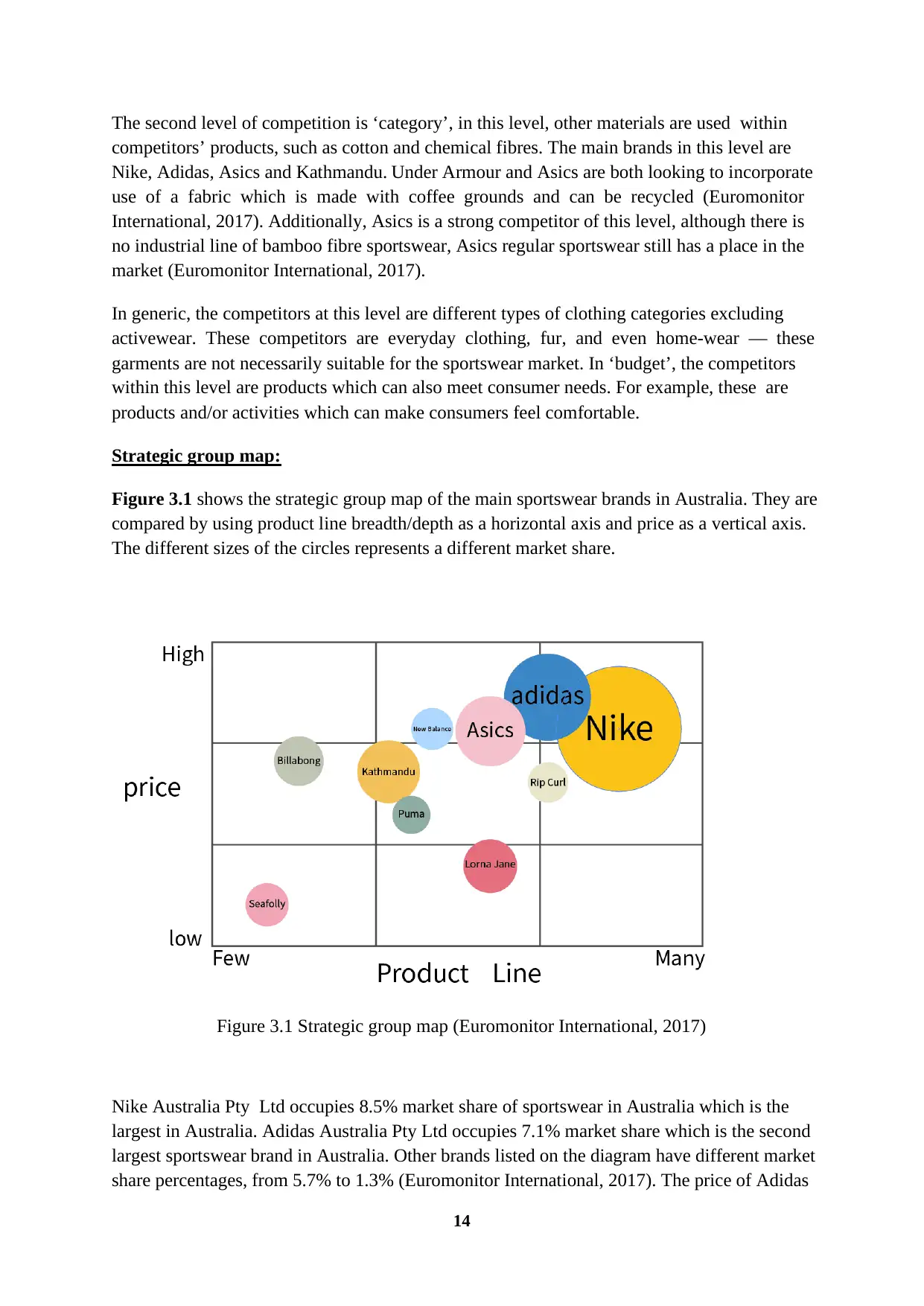
14
The second level of competition is ‘category’, in this level, other materials are used within
competitors’ products, such as cotton and chemical fibres. The main brands in this level are
Nike, Adidas, Asics and Kathmandu. Under Armour and Asics are both looking to incorporate
use of a fabric which is made with coffee grounds and can be recycled (Euromonitor
International, 2017). Additionally, Asics is a strong competitor of this level, although there is
no industrial line of bamboo fibre sportswear, Asics regular sportswear still has a place in the
market (Euromonitor International, 2017).
In generic, the competitors at this level are different types of clothing categories excluding
activewear. These competitors are everyday clothing, fur, and even home-wear — these
garments are not necessarily suitable for the sportswear market. In ‘budget’, the competitors
within this level are products which can also meet consumer needs. For example, these are
products and/or activities which can make consumers feel comfortable.
Strategic group map:
Figure 3.1 shows the strategic group map of the main sportswear brands in Australia. They are
compared by using product line breadth/depth as a horizontal axis and price as a vertical axis.
The different sizes of the circles represents a different market share.
Figure 3.1 Strategic group map (Euromonitor International, 2017)
Nike Australia Pty Ltd occupies 8.5% market share of sportswear in Australia which is the
largest in Australia. Adidas Australia Pty Ltd occupies 7.1% market share which is the second
largest sportswear brand in Australia. Other brands listed on the diagram have different market
share percentages, from 5.7% to 1.3% (Euromonitor International, 2017). The price of Adidas
The second level of competition is ‘category’, in this level, other materials are used within
competitors’ products, such as cotton and chemical fibres. The main brands in this level are
Nike, Adidas, Asics and Kathmandu. Under Armour and Asics are both looking to incorporate
use of a fabric which is made with coffee grounds and can be recycled (Euromonitor
International, 2017). Additionally, Asics is a strong competitor of this level, although there is
no industrial line of bamboo fibre sportswear, Asics regular sportswear still has a place in the
market (Euromonitor International, 2017).
In generic, the competitors at this level are different types of clothing categories excluding
activewear. These competitors are everyday clothing, fur, and even home-wear — these
garments are not necessarily suitable for the sportswear market. In ‘budget’, the competitors
within this level are products which can also meet consumer needs. For example, these are
products and/or activities which can make consumers feel comfortable.
Strategic group map:
Figure 3.1 shows the strategic group map of the main sportswear brands in Australia. They are
compared by using product line breadth/depth as a horizontal axis and price as a vertical axis.
The different sizes of the circles represents a different market share.
Figure 3.1 Strategic group map (Euromonitor International, 2017)
Nike Australia Pty Ltd occupies 8.5% market share of sportswear in Australia which is the
largest in Australia. Adidas Australia Pty Ltd occupies 7.1% market share which is the second
largest sportswear brand in Australia. Other brands listed on the diagram have different market
share percentages, from 5.7% to 1.3% (Euromonitor International, 2017). The price of Adidas
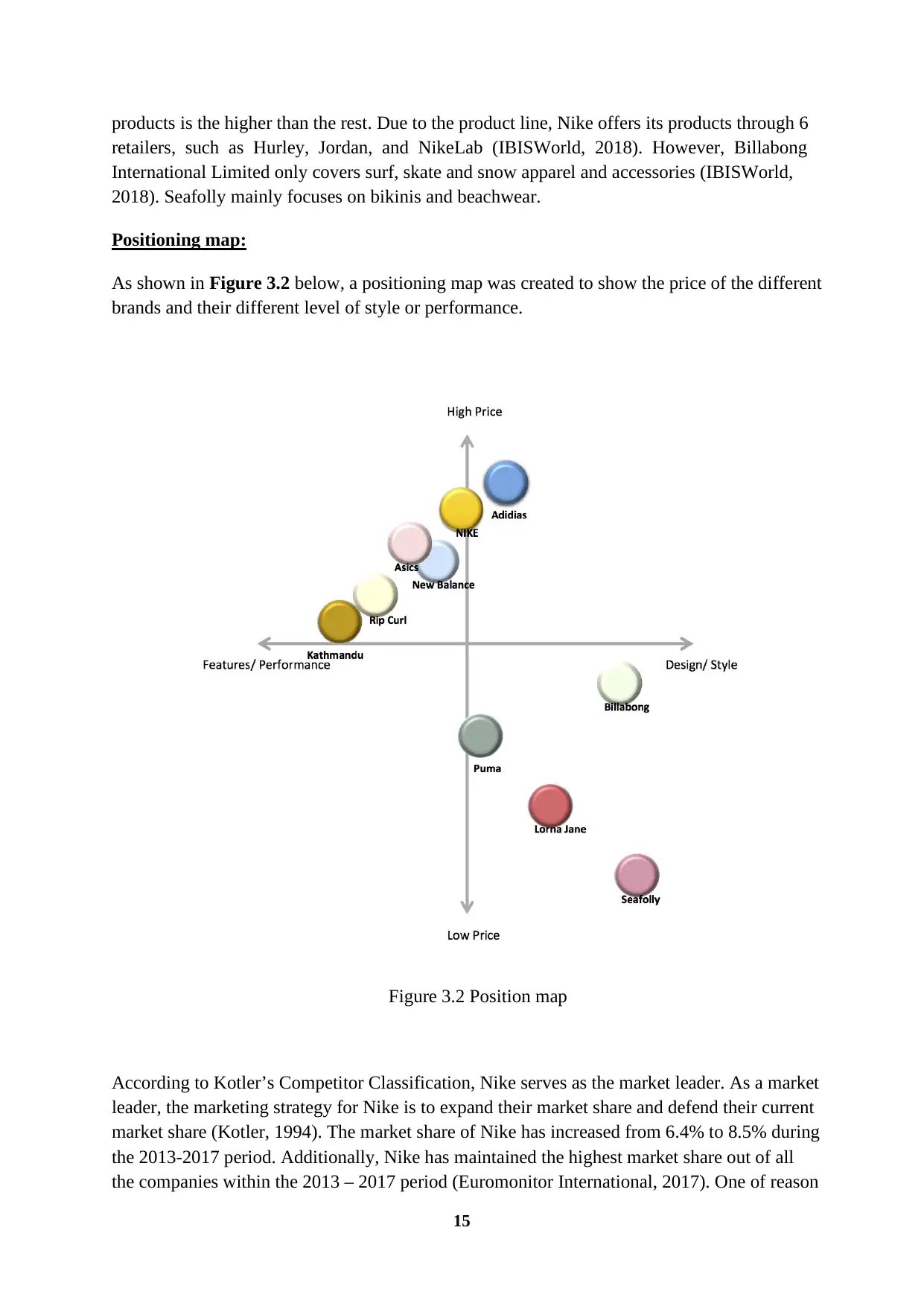
15
products is the higher than the rest. Due to the product line, Nike offers its products through 6
retailers, such as Hurley, Jordan, and NikeLab (IBISWorld, 2018). However, Billabong
International Limited only covers surf, skate and snow apparel and accessories (IBISWorld,
2018). Seafolly mainly focuses on bikinis and beachwear.
Positioning map:
As shown in Figure 3.2 below, a positioning map was created to show the price of the different
brands and their different level of style or performance.
Figure 3.2 Position map
According to Kotler’s Competitor Classification, Nike serves as the market leader. As a market
leader, the marketing strategy for Nike is to expand their market share and defend their current
market share (Kotler, 1994). The market share of Nike has increased from 6.4% to 8.5% during
the 2013-2017 period. Additionally, Nike has maintained the highest market share out of all
the companies within the 2013 – 2017 period (Euromonitor International, 2017). One of reason
products is the higher than the rest. Due to the product line, Nike offers its products through 6
retailers, such as Hurley, Jordan, and NikeLab (IBISWorld, 2018). However, Billabong
International Limited only covers surf, skate and snow apparel and accessories (IBISWorld,
2018). Seafolly mainly focuses on bikinis and beachwear.
Positioning map:
As shown in Figure 3.2 below, a positioning map was created to show the price of the different
brands and their different level of style or performance.
Figure 3.2 Position map
According to Kotler’s Competitor Classification, Nike serves as the market leader. As a market
leader, the marketing strategy for Nike is to expand their market share and defend their current
market share (Kotler, 1994). The market share of Nike has increased from 6.4% to 8.5% during
the 2013-2017 period. Additionally, Nike has maintained the highest market share out of all
the companies within the 2013 – 2017 period (Euromonitor International, 2017). One of reason
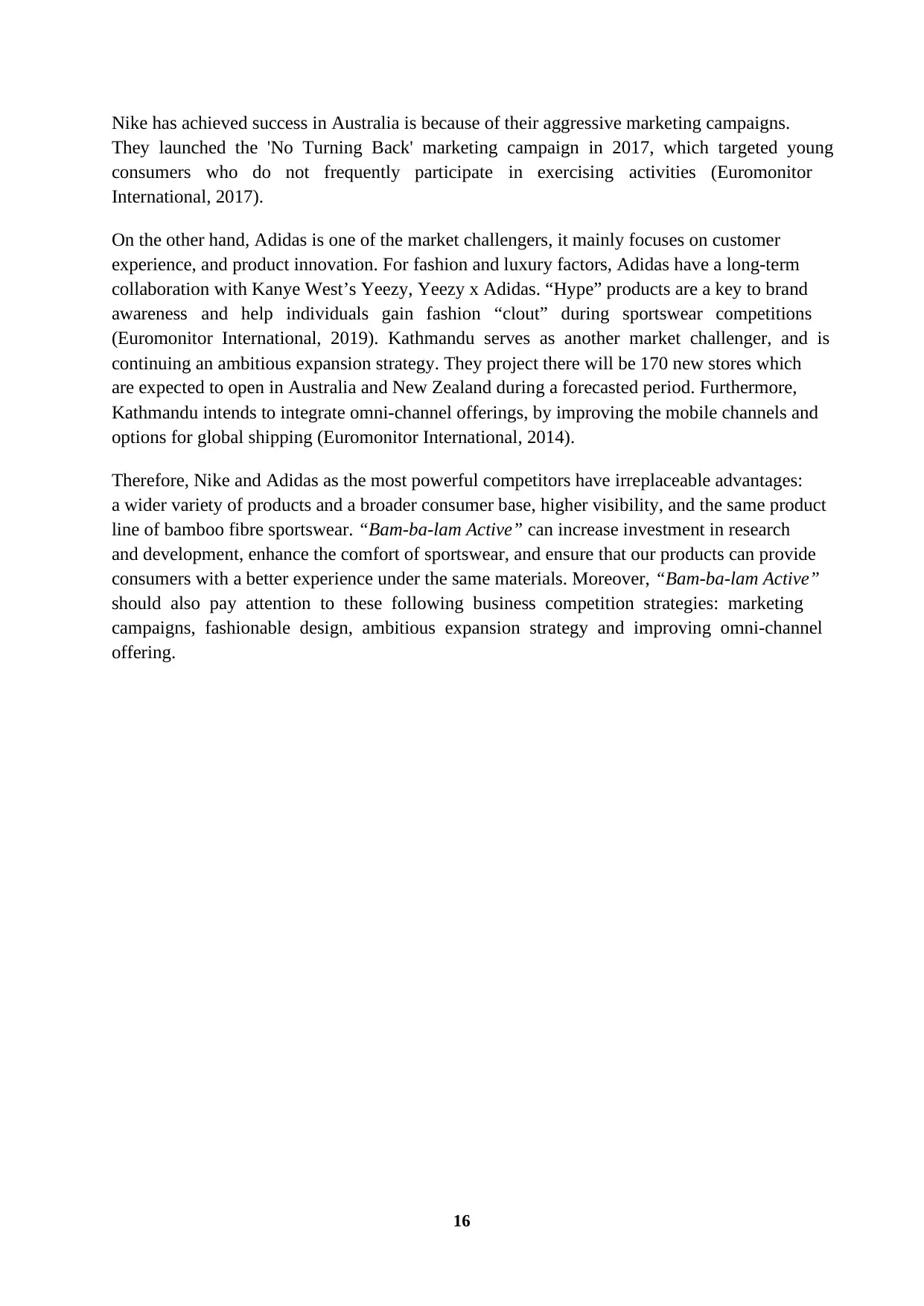
16
Nike has achieved success in Australia is because of their aggressive marketing campaigns.
They launched the 'No Turning Back' marketing campaign in 2017, which targeted young
consumers who do not frequently participate in exercising activities (Euromonitor
International, 2017).
On the other hand, Adidas is one of the market challengers, it mainly focuses on customer
experience, and product innovation. For fashion and luxury factors, Adidas have a long-term
collaboration with Kanye West’s Yeezy, Yeezy x Adidas. “Hype” products are a key to brand
awareness and help individuals gain fashion “clout” during sportswear competitions
(Euromonitor International, 2019). Kathmandu serves as another market challenger, and is
continuing an ambitious expansion strategy. They project there will be 170 new stores which
are expected to open in Australia and New Zealand during a forecasted period. Furthermore,
Kathmandu intends to integrate omni-channel offerings, by improving the mobile channels and
options for global shipping (Euromonitor International, 2014).
Therefore, Nike and Adidas as the most powerful competitors have irreplaceable advantages:
a wider variety of products and a broader consumer base, higher visibility, and the same product
line of bamboo fibre sportswear. “Bam-ba-lam Active” can increase investment in research
and development, enhance the comfort of sportswear, and ensure that our products can provide
consumers with a better experience under the same materials. Moreover, “Bam-ba-lam Active”
should also pay attention to these following business competition strategies: marketing
campaigns, fashionable design, ambitious expansion strategy and improving omni-channel
offering.
Nike has achieved success in Australia is because of their aggressive marketing campaigns.
They launched the 'No Turning Back' marketing campaign in 2017, which targeted young
consumers who do not frequently participate in exercising activities (Euromonitor
International, 2017).
On the other hand, Adidas is one of the market challengers, it mainly focuses on customer
experience, and product innovation. For fashion and luxury factors, Adidas have a long-term
collaboration with Kanye West’s Yeezy, Yeezy x Adidas. “Hype” products are a key to brand
awareness and help individuals gain fashion “clout” during sportswear competitions
(Euromonitor International, 2019). Kathmandu serves as another market challenger, and is
continuing an ambitious expansion strategy. They project there will be 170 new stores which
are expected to open in Australia and New Zealand during a forecasted period. Furthermore,
Kathmandu intends to integrate omni-channel offerings, by improving the mobile channels and
options for global shipping (Euromonitor International, 2014).
Therefore, Nike and Adidas as the most powerful competitors have irreplaceable advantages:
a wider variety of products and a broader consumer base, higher visibility, and the same product
line of bamboo fibre sportswear. “Bam-ba-lam Active” can increase investment in research
and development, enhance the comfort of sportswear, and ensure that our products can provide
consumers with a better experience under the same materials. Moreover, “Bam-ba-lam Active”
should also pay attention to these following business competition strategies: marketing
campaigns, fashionable design, ambitious expansion strategy and improving omni-channel
offering.
Secure Best Marks with AI Grader
Need help grading? Try our AI Grader for instant feedback on your assignments.
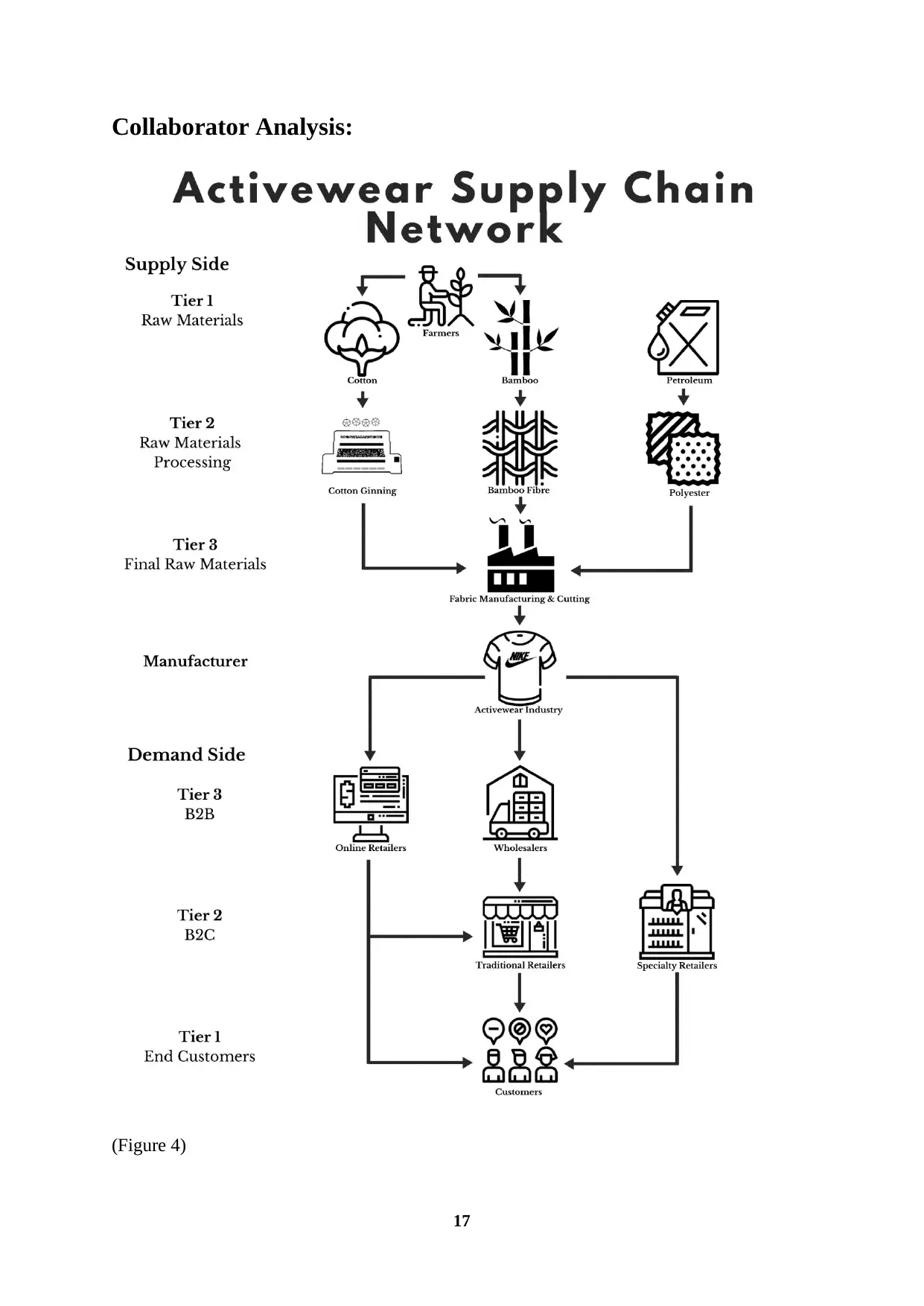
17
Collaborator Analysis:
(Figure 4)
Collaborator Analysis:
(Figure 4)
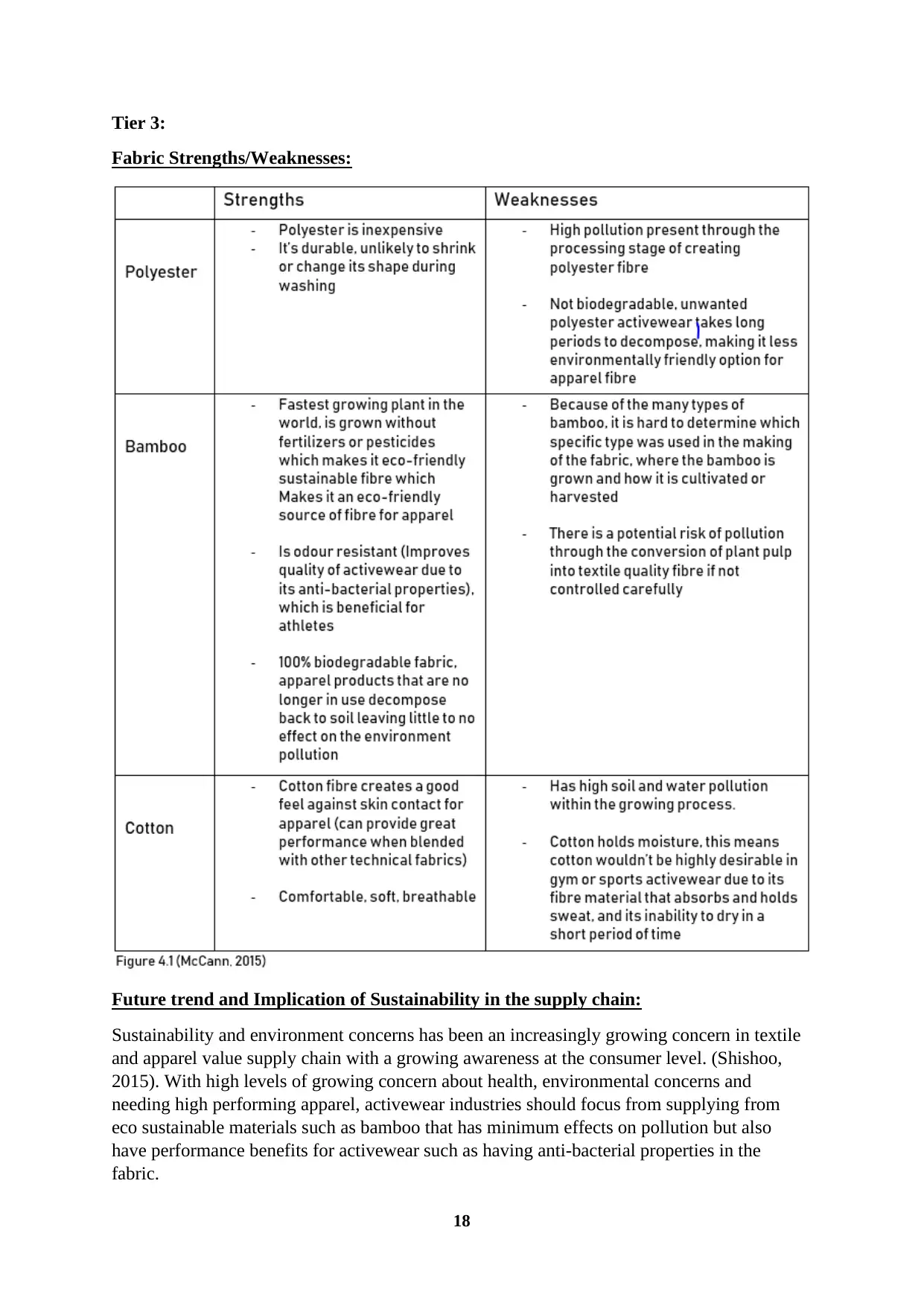
18
Tier 3:
Fabric Strengths/Weaknesses:
Future trend and Implication of Sustainability in the supply chain:
Sustainability and environment concerns has been an increasingly growing concern in textile
and apparel value supply chain with a growing awareness at the consumer level. (Shishoo,
2015). With high levels of growing concern about health, environmental concerns and
needing high performing apparel, activewear industries should focus from supplying from
eco sustainable materials such as bamboo that has minimum effects on pollution but also
have performance benefits for activewear such as having anti-bacterial properties in the
fabric.
Tier 3:
Fabric Strengths/Weaknesses:
Future trend and Implication of Sustainability in the supply chain:
Sustainability and environment concerns has been an increasingly growing concern in textile
and apparel value supply chain with a growing awareness at the consumer level. (Shishoo,
2015). With high levels of growing concern about health, environmental concerns and
needing high performing apparel, activewear industries should focus from supplying from
eco sustainable materials such as bamboo that has minimum effects on pollution but also
have performance benefits for activewear such as having anti-bacterial properties in the
fabric.
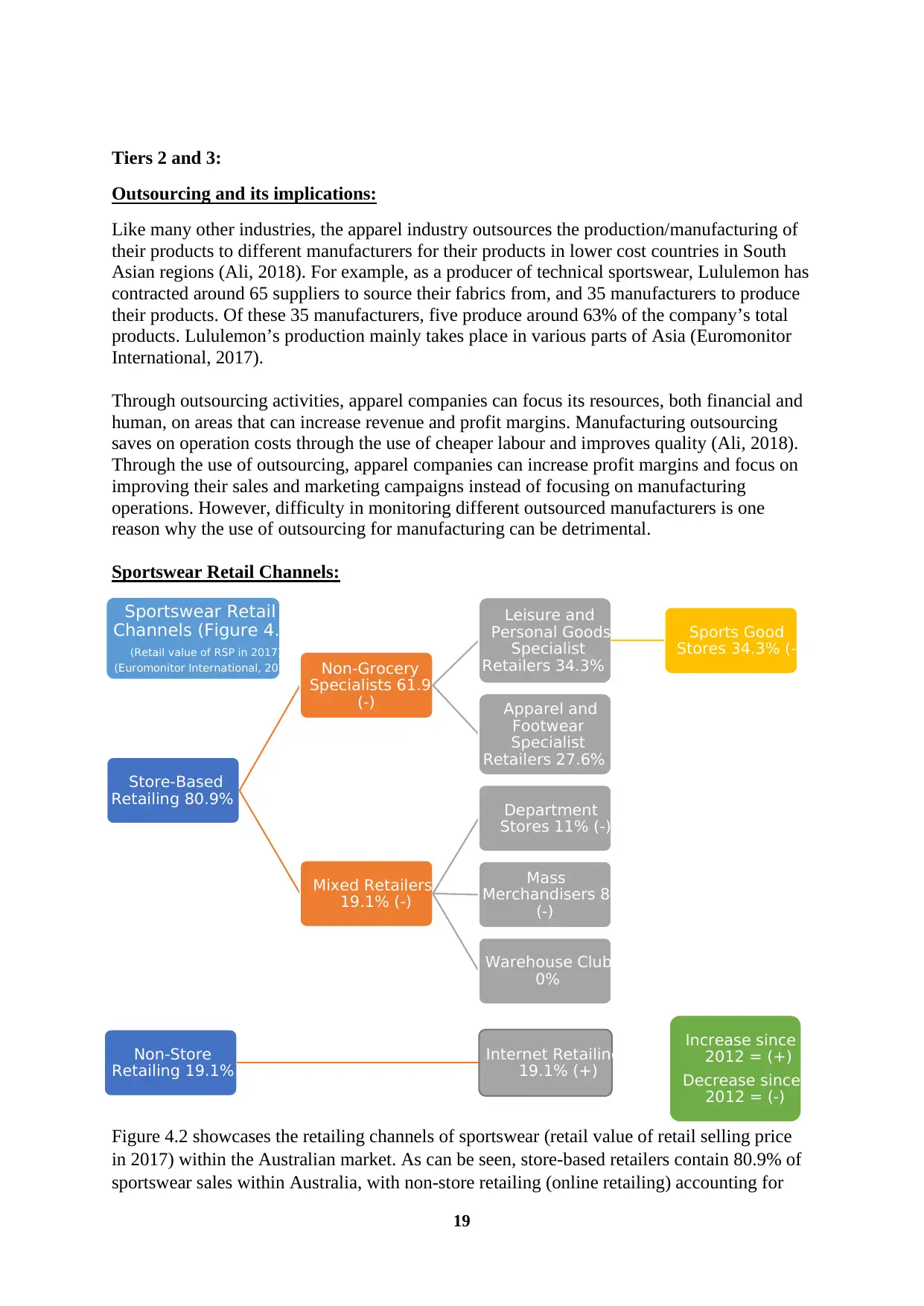
19
Tiers 2 and 3:
Outsourcing and its implications:
Like many other industries, the apparel industry outsources the production/manufacturing of
their products to different manufacturers for their products in lower cost countries in South
Asian regions (Ali, 2018). For example, as a producer of technical sportswear, Lululemon has
contracted around 65 suppliers to source their fabrics from, and 35 manufacturers to produce
their products. Of these 35 manufacturers, five produce around 63% of the company’s total
products. Lululemon’s production mainly takes place in various parts of Asia (Euromonitor
International, 2017).
Through outsourcing activities, apparel companies can focus its resources, both financial and
human, on areas that can increase revenue and profit margins. Manufacturing outsourcing
saves on operation costs through the use of cheaper labour and improves quality (Ali, 2018).
Through the use of outsourcing, apparel companies can increase profit margins and focus on
improving their sales and marketing campaigns instead of focusing on manufacturing
operations. However, difficulty in monitoring different outsourced manufacturers is one
reason why the use of outsourcing for manufacturing can be detrimental.
Sportswear Retail Channels:
Figure 4.2 showcases the retailing channels of sportswear (retail value of retail selling price
in 2017) within the Australian market. As can be seen, store-based retailers contain 80.9% of
sportswear sales within Australia, with non-store retailing (online retailing) accounting for
Store-Based
Retailing 80.9% (-)
Non-Grocery
Specialists 61.9%
(-)
Leisure and
Personal Goods
Specialist
Retailers 34.3% (-)
Sports Good
Stores 34.3% (-)
Apparel and
Footwear
Specialist
Retailers 27.6% (-)
Mixed Retailers
19.1% (-)
Department
Stores 11% (-)
Mass
Merchandisers 8%
(-)
Warehouse Clubs
0%
Non-Store
Retailing 19.1% (+)
Internet Retailing
19.1% (+)
Sportswear Retail
Channels (Figure 4.2)
(Retail value of RSP in 2017)
(Euromonitor International, 2017)
Increase since
2012 = (+)
Decrease since
2012 = (-)
Tiers 2 and 3:
Outsourcing and its implications:
Like many other industries, the apparel industry outsources the production/manufacturing of
their products to different manufacturers for their products in lower cost countries in South
Asian regions (Ali, 2018). For example, as a producer of technical sportswear, Lululemon has
contracted around 65 suppliers to source their fabrics from, and 35 manufacturers to produce
their products. Of these 35 manufacturers, five produce around 63% of the company’s total
products. Lululemon’s production mainly takes place in various parts of Asia (Euromonitor
International, 2017).
Through outsourcing activities, apparel companies can focus its resources, both financial and
human, on areas that can increase revenue and profit margins. Manufacturing outsourcing
saves on operation costs through the use of cheaper labour and improves quality (Ali, 2018).
Through the use of outsourcing, apparel companies can increase profit margins and focus on
improving their sales and marketing campaigns instead of focusing on manufacturing
operations. However, difficulty in monitoring different outsourced manufacturers is one
reason why the use of outsourcing for manufacturing can be detrimental.
Sportswear Retail Channels:
Figure 4.2 showcases the retailing channels of sportswear (retail value of retail selling price
in 2017) within the Australian market. As can be seen, store-based retailers contain 80.9% of
sportswear sales within Australia, with non-store retailing (online retailing) accounting for
Store-Based
Retailing 80.9% (-)
Non-Grocery
Specialists 61.9%
(-)
Leisure and
Personal Goods
Specialist
Retailers 34.3% (-)
Sports Good
Stores 34.3% (-)
Apparel and
Footwear
Specialist
Retailers 27.6% (-)
Mixed Retailers
19.1% (-)
Department
Stores 11% (-)
Mass
Merchandisers 8%
(-)
Warehouse Clubs
0%
Non-Store
Retailing 19.1% (+)
Internet Retailing
19.1% (+)
Sportswear Retail
Channels (Figure 4.2)
(Retail value of RSP in 2017)
(Euromonitor International, 2017)
Increase since
2012 = (+)
Decrease since
2012 = (-)
Paraphrase This Document
Need a fresh take? Get an instant paraphrase of this document with our AI Paraphraser
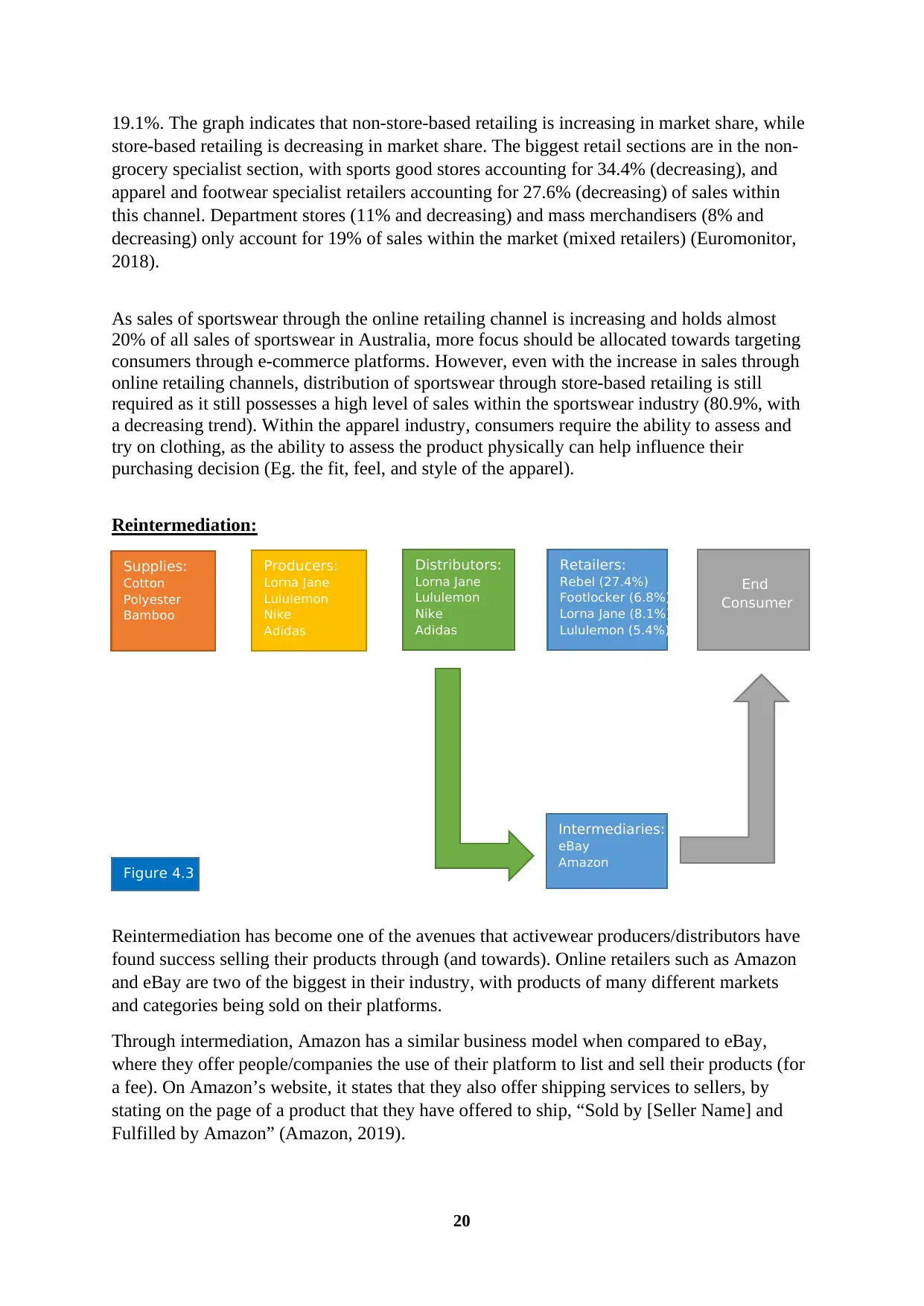
20
19.1%. The graph indicates that non-store-based retailing is increasing in market share, while
store-based retailing is decreasing in market share. The biggest retail sections are in the non-
grocery specialist section, with sports good stores accounting for 34.4% (decreasing), and
apparel and footwear specialist retailers accounting for 27.6% (decreasing) of sales within
this channel. Department stores (11% and decreasing) and mass merchandisers (8% and
decreasing) only account for 19% of sales within the market (mixed retailers) (Euromonitor,
2018).
As sales of sportswear through the online retailing channel is increasing and holds almost
20% of all sales of sportswear in Australia, more focus should be allocated towards targeting
consumers through e-commerce platforms. However, even with the increase in sales through
online retailing channels, distribution of sportswear through store-based retailing is still
required as it still possesses a high level of sales within the sportswear industry (80.9%, with
a decreasing trend). Within the apparel industry, consumers require the ability to assess and
try on clothing, as the ability to assess the product physically can help influence their
purchasing decision (Eg. the fit, feel, and style of the apparel).
Reintermediation:
Reintermediation has become one of the avenues that activewear producers/distributors have
found success selling their products through (and towards). Online retailers such as Amazon
and eBay are two of the biggest in their industry, with products of many different markets
and categories being sold on their platforms.
Through intermediation, Amazon has a similar business model when compared to eBay,
where they offer people/companies the use of their platform to list and sell their products (for
a fee). On Amazon’s website, it states that they also offer shipping services to sellers, by
stating on the page of a product that they have offered to ship, “Sold by [Seller Name] and
Fulfilled by Amazon” (Amazon, 2019).
Figure 4.3
Supplies:
Cotton
Polyester
Bamboo
Producers:
Lorna Jane
Lululemon
Nike
Adidas
Distributors:
Lorna Jane
Lululemon
Nike
Adidas
Retailers:
Rebel (27.4%)
Footlocker (6.8%)
Lorna Jane (8.1%)
Lululemon (5.4%)
End
Consumer
Intermediaries:
eBay
Amazon
19.1%. The graph indicates that non-store-based retailing is increasing in market share, while
store-based retailing is decreasing in market share. The biggest retail sections are in the non-
grocery specialist section, with sports good stores accounting for 34.4% (decreasing), and
apparel and footwear specialist retailers accounting for 27.6% (decreasing) of sales within
this channel. Department stores (11% and decreasing) and mass merchandisers (8% and
decreasing) only account for 19% of sales within the market (mixed retailers) (Euromonitor,
2018).
As sales of sportswear through the online retailing channel is increasing and holds almost
20% of all sales of sportswear in Australia, more focus should be allocated towards targeting
consumers through e-commerce platforms. However, even with the increase in sales through
online retailing channels, distribution of sportswear through store-based retailing is still
required as it still possesses a high level of sales within the sportswear industry (80.9%, with
a decreasing trend). Within the apparel industry, consumers require the ability to assess and
try on clothing, as the ability to assess the product physically can help influence their
purchasing decision (Eg. the fit, feel, and style of the apparel).
Reintermediation:
Reintermediation has become one of the avenues that activewear producers/distributors have
found success selling their products through (and towards). Online retailers such as Amazon
and eBay are two of the biggest in their industry, with products of many different markets
and categories being sold on their platforms.
Through intermediation, Amazon has a similar business model when compared to eBay,
where they offer people/companies the use of their platform to list and sell their products (for
a fee). On Amazon’s website, it states that they also offer shipping services to sellers, by
stating on the page of a product that they have offered to ship, “Sold by [Seller Name] and
Fulfilled by Amazon” (Amazon, 2019).
Figure 4.3
Supplies:
Cotton
Polyester
Bamboo
Producers:
Lorna Jane
Lululemon
Nike
Adidas
Distributors:
Lorna Jane
Lululemon
Nike
Adidas
Retailers:
Rebel (27.4%)
Footlocker (6.8%)
Lorna Jane (8.1%)
Lululemon (5.4%)
End
Consumer
Intermediaries:
eBay
Amazon
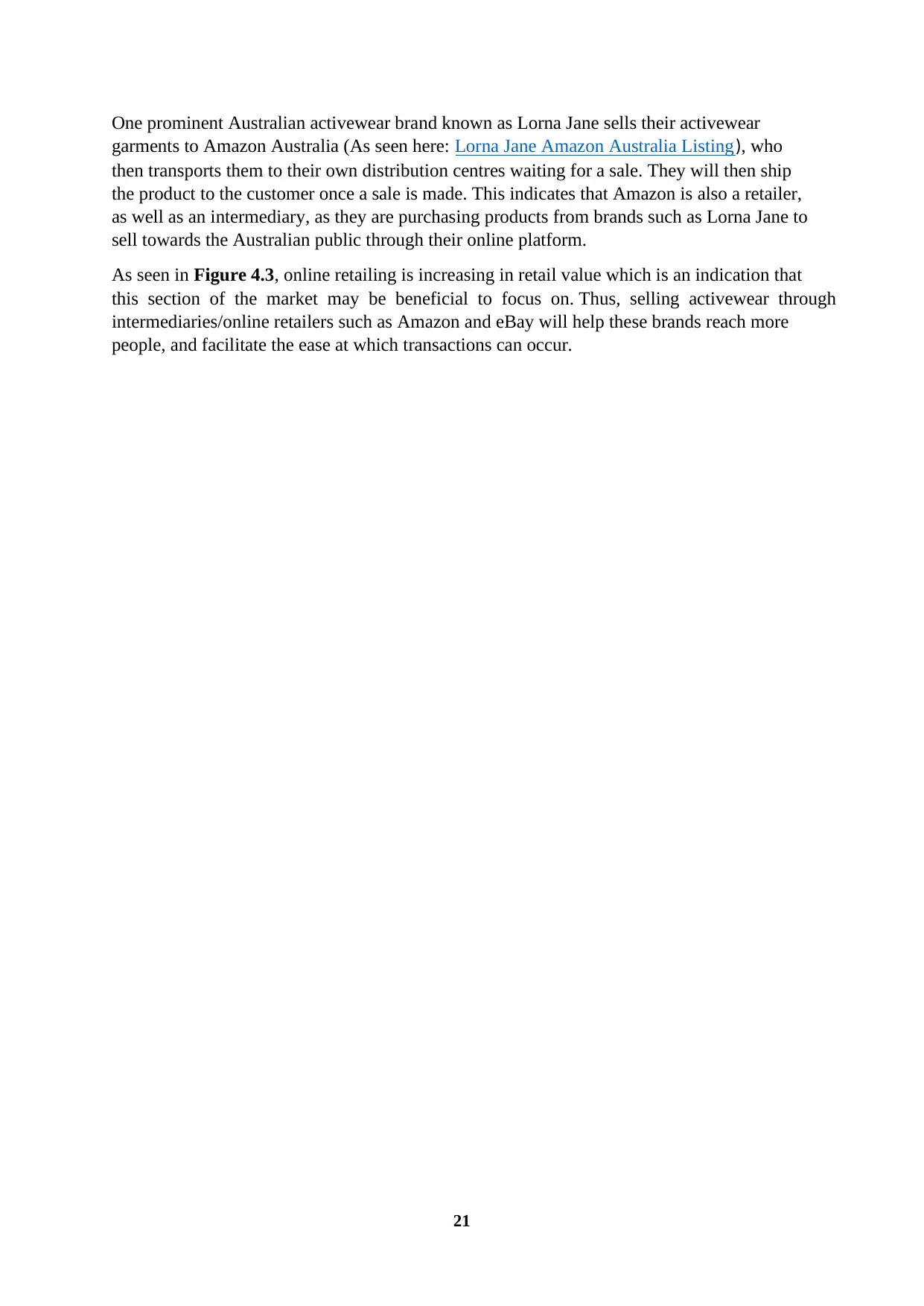
21
One prominent Australian activewear brand known as Lorna Jane sells their activewear
garments to Amazon Australia (As seen here: Lorna Jane Amazon Australia Listing), who
then transports them to their own distribution centres waiting for a sale. They will then ship
the product to the customer once a sale is made. This indicates that Amazon is also a retailer,
as well as an intermediary, as they are purchasing products from brands such as Lorna Jane to
sell towards the Australian public through their online platform.
As seen in Figure 4.3, online retailing is increasing in retail value which is an indication that
this section of the market may be beneficial to focus on. Thus, selling activewear through
intermediaries/online retailers such as Amazon and eBay will help these brands reach more
people, and facilitate the ease at which transactions can occur.
One prominent Australian activewear brand known as Lorna Jane sells their activewear
garments to Amazon Australia (As seen here: Lorna Jane Amazon Australia Listing), who
then transports them to their own distribution centres waiting for a sale. They will then ship
the product to the customer once a sale is made. This indicates that Amazon is also a retailer,
as well as an intermediary, as they are purchasing products from brands such as Lorna Jane to
sell towards the Australian public through their online platform.
As seen in Figure 4.3, online retailing is increasing in retail value which is an indication that
this section of the market may be beneficial to focus on. Thus, selling activewear through
intermediaries/online retailers such as Amazon and eBay will help these brands reach more
people, and facilitate the ease at which transactions can occur.
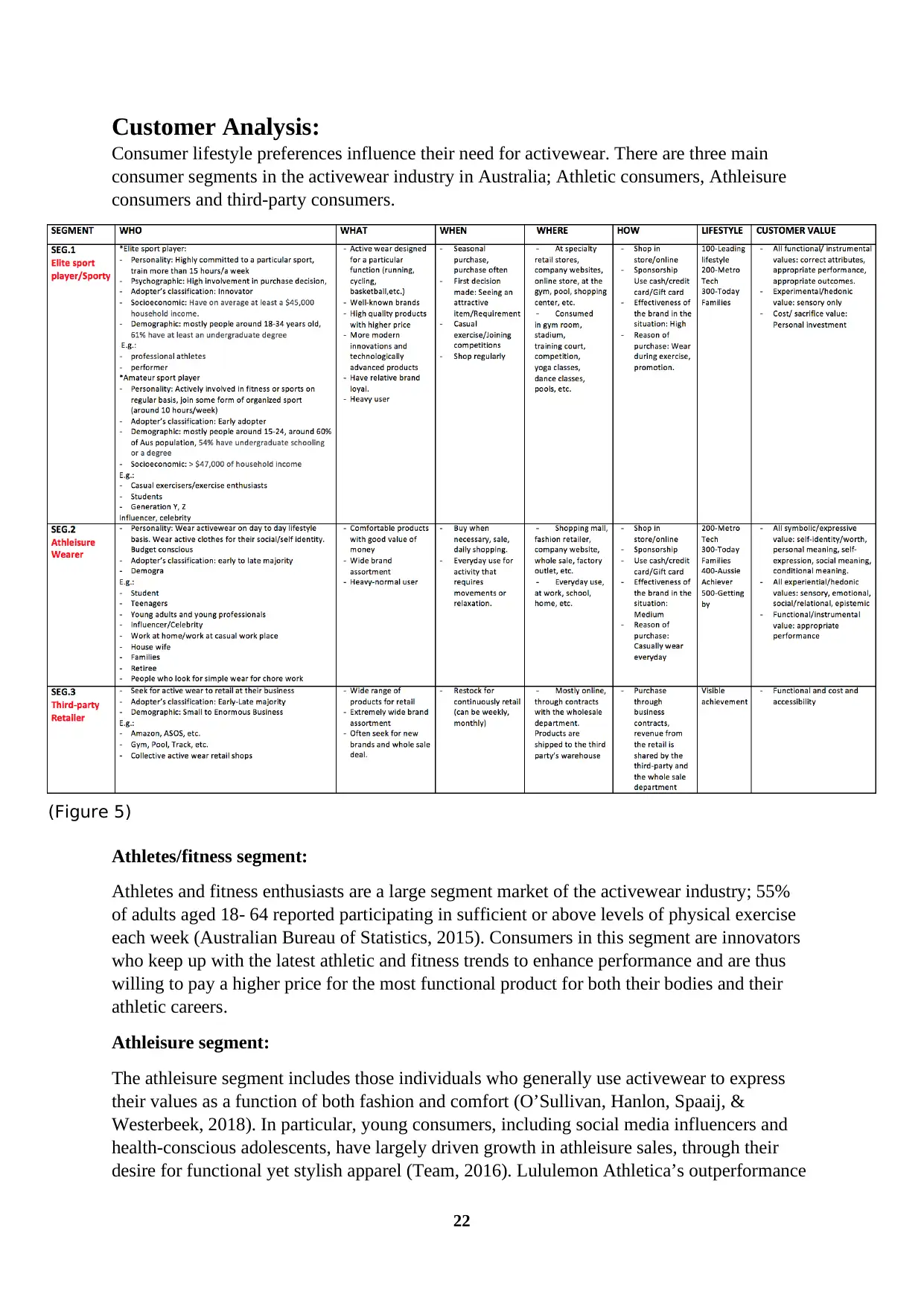
22
(Figure 5)
Customer Analysis:
Consumer lifestyle preferences influence their need for activewear. There are three main
consumer segments in the activewear industry in Australia; Athletic consumers, Athleisure
consumers and third-party consumers.
Athletes/fitness segment:
Athletes and fitness enthusiasts are a large segment market of the activewear industry; 55%
of adults aged 18- 64 reported participating in sufficient or above levels of physical exercise
each week (Australian Bureau of Statistics, 2015). Consumers in this segment are innovators
who keep up with the latest athletic and fitness trends to enhance performance and are thus
willing to pay a higher price for the most functional product for both their bodies and their
athletic careers.
Athleisure segment:
The athleisure segment includes those individuals who generally use activewear to express
their values as a function of both fashion and comfort (O’Sullivan, Hanlon, Spaaij, &
Westerbeek, 2018). In particular, young consumers, including social media influencers and
health-conscious adolescents, have largely driven growth in athleisure sales, through their
desire for functional yet stylish apparel (Team, 2016). Lululemon Athletica’s outperformance
(Figure 5)
Customer Analysis:
Consumer lifestyle preferences influence their need for activewear. There are three main
consumer segments in the activewear industry in Australia; Athletic consumers, Athleisure
consumers and third-party consumers.
Athletes/fitness segment:
Athletes and fitness enthusiasts are a large segment market of the activewear industry; 55%
of adults aged 18- 64 reported participating in sufficient or above levels of physical exercise
each week (Australian Bureau of Statistics, 2015). Consumers in this segment are innovators
who keep up with the latest athletic and fitness trends to enhance performance and are thus
willing to pay a higher price for the most functional product for both their bodies and their
athletic careers.
Athleisure segment:
The athleisure segment includes those individuals who generally use activewear to express
their values as a function of both fashion and comfort (O’Sullivan, Hanlon, Spaaij, &
Westerbeek, 2018). In particular, young consumers, including social media influencers and
health-conscious adolescents, have largely driven growth in athleisure sales, through their
desire for functional yet stylish apparel (Team, 2016). Lululemon Athletica’s outperformance
Secure Best Marks with AI Grader
Need help grading? Try our AI Grader for instant feedback on your assignments.
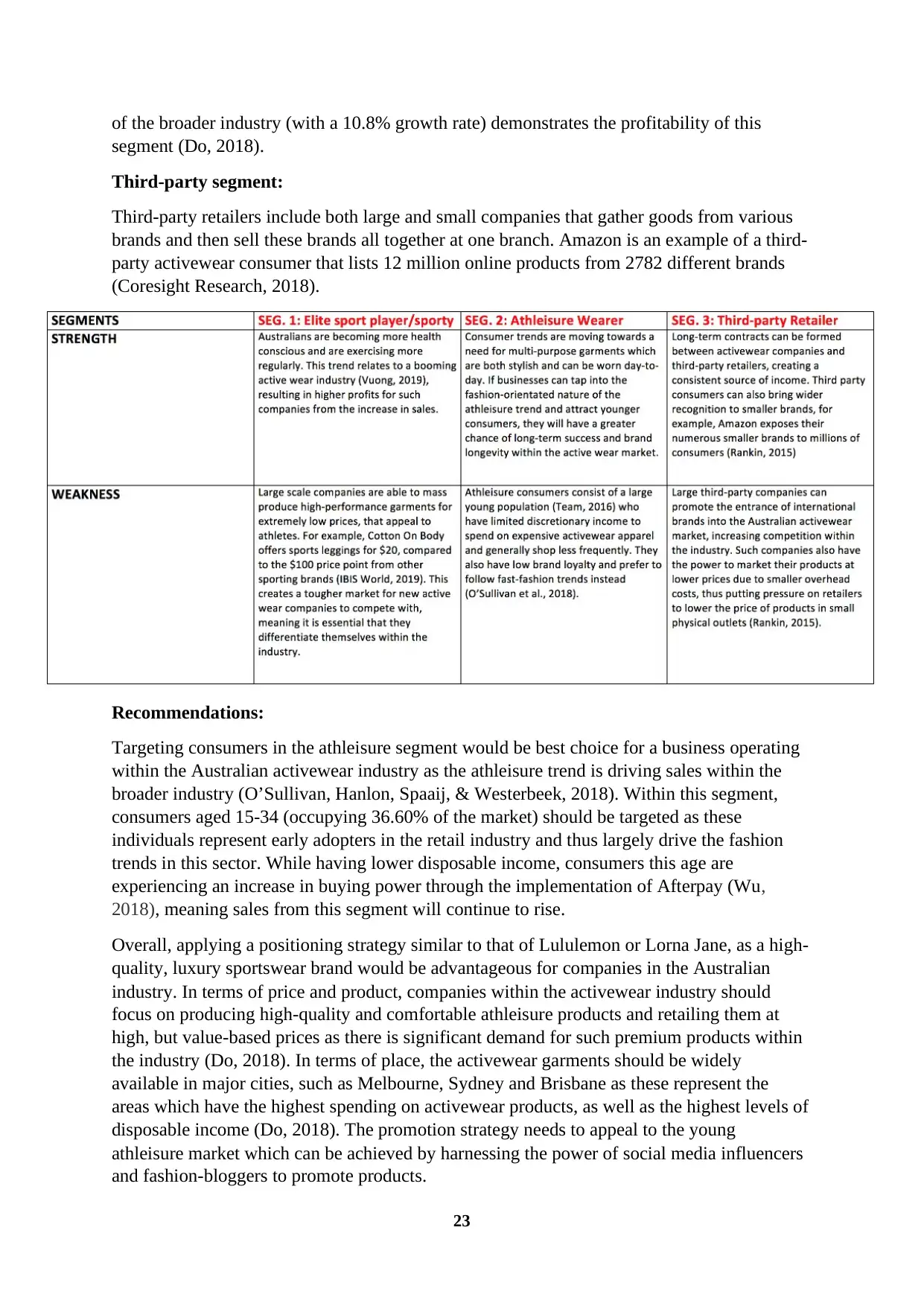
23
of the broader industry (with a 10.8% growth rate) demonstrates the profitability of this
segment (Do, 2018).
Third-party segment:
Third-party retailers include both large and small companies that gather goods from various
brands and then sell these brands all together at one branch. Amazon is an example of a third-
party activewear consumer that lists 12 million online products from 2782 different brands
(Coresight Research, 2018).
Recommendations:
Targeting consumers in the athleisure segment would be best choice for a business operating
within the Australian activewear industry as the athleisure trend is driving sales within the
broader industry (O’Sullivan, Hanlon, Spaaij, & Westerbeek, 2018). Within this segment,
consumers aged 15-34 (occupying 36.60% of the market) should be targeted as these
individuals represent early adopters in the retail industry and thus largely drive the fashion
trends in this sector. While having lower disposable income, consumers this age are
experiencing an increase in buying power through the implementation of Afterpay (Wu,
2018), meaning sales from this segment will continue to rise.
Overall, applying a positioning strategy similar to that of Lululemon or Lorna Jane, as a high-
quality, luxury sportswear brand would be advantageous for companies in the Australian
industry. In terms of price and product, companies within the activewear industry should
focus on producing high-quality and comfortable athleisure products and retailing them at
high, but value-based prices as there is significant demand for such premium products within
the industry (Do, 2018). In terms of place, the activewear garments should be widely
available in major cities, such as Melbourne, Sydney and Brisbane as these represent the
areas which have the highest spending on activewear products, as well as the highest levels of
disposable income (Do, 2018). The promotion strategy needs to appeal to the young
athleisure market which can be achieved by harnessing the power of social media influencers
and fashion-bloggers to promote products.
of the broader industry (with a 10.8% growth rate) demonstrates the profitability of this
segment (Do, 2018).
Third-party segment:
Third-party retailers include both large and small companies that gather goods from various
brands and then sell these brands all together at one branch. Amazon is an example of a third-
party activewear consumer that lists 12 million online products from 2782 different brands
(Coresight Research, 2018).
Recommendations:
Targeting consumers in the athleisure segment would be best choice for a business operating
within the Australian activewear industry as the athleisure trend is driving sales within the
broader industry (O’Sullivan, Hanlon, Spaaij, & Westerbeek, 2018). Within this segment,
consumers aged 15-34 (occupying 36.60% of the market) should be targeted as these
individuals represent early adopters in the retail industry and thus largely drive the fashion
trends in this sector. While having lower disposable income, consumers this age are
experiencing an increase in buying power through the implementation of Afterpay (Wu,
2018), meaning sales from this segment will continue to rise.
Overall, applying a positioning strategy similar to that of Lululemon or Lorna Jane, as a high-
quality, luxury sportswear brand would be advantageous for companies in the Australian
industry. In terms of price and product, companies within the activewear industry should
focus on producing high-quality and comfortable athleisure products and retailing them at
high, but value-based prices as there is significant demand for such premium products within
the industry (Do, 2018). In terms of place, the activewear garments should be widely
available in major cities, such as Melbourne, Sydney and Brisbane as these represent the
areas which have the highest spending on activewear products, as well as the highest levels of
disposable income (Do, 2018). The promotion strategy needs to appeal to the young
athleisure market which can be achieved by harnessing the power of social media influencers
and fashion-bloggers to promote products.
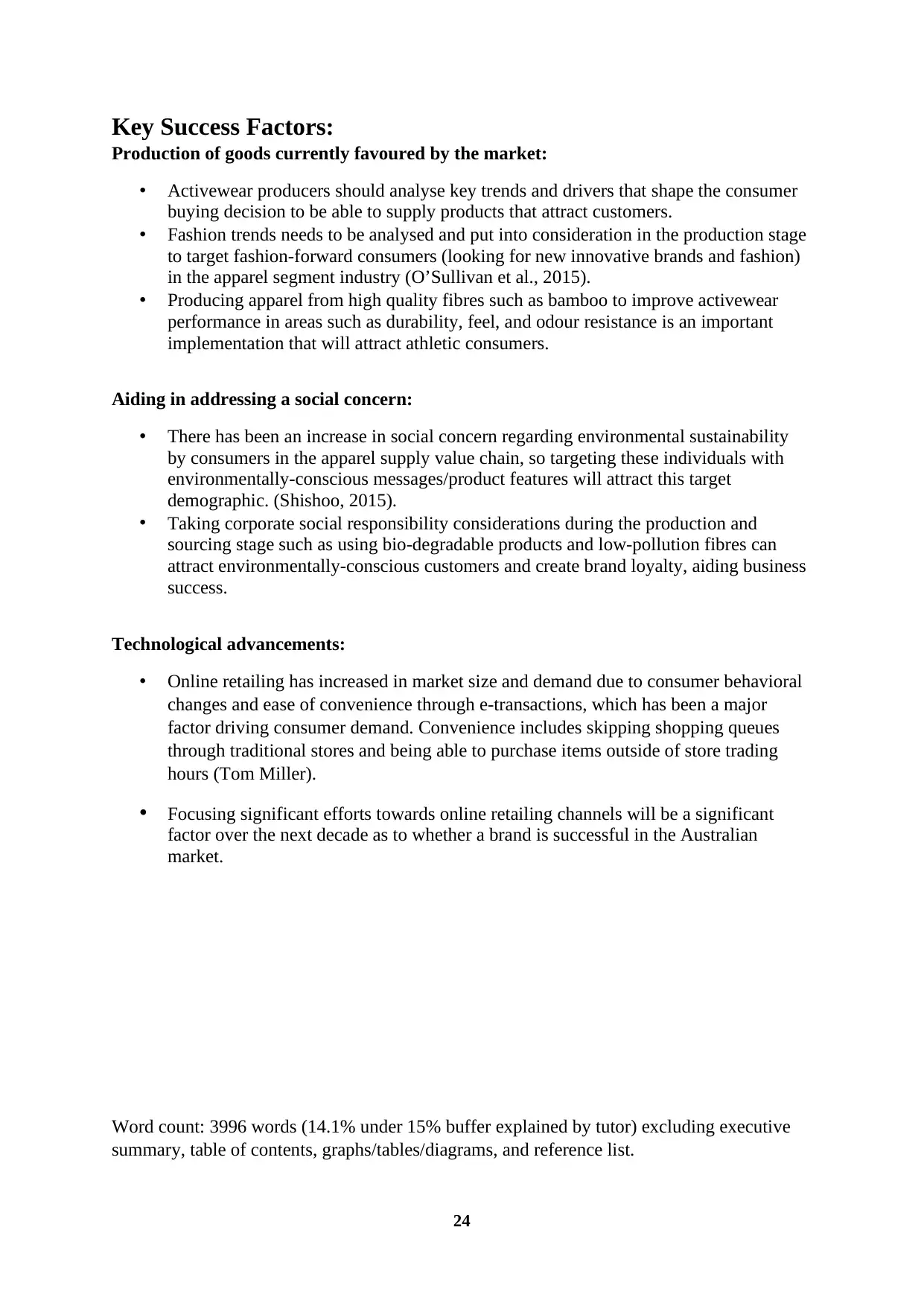
24
Key Success Factors:
Production of goods currently favoured by the market:
• Activewear producers should analyse key trends and drivers that shape the consumer
buying decision to be able to supply products that attract customers.
• Fashion trends needs to be analysed and put into consideration in the production stage
to target fashion-forward consumers (looking for new innovative brands and fashion)
in the apparel segment industry (O’Sullivan et al., 2015).
• Producing apparel from high quality fibres such as bamboo to improve activewear
performance in areas such as durability, feel, and odour resistance is an important
implementation that will attract athletic consumers.
Aiding in addressing a social concern:
• There has been an increase in social concern regarding environmental sustainability
by consumers in the apparel supply value chain, so targeting these individuals with
environmentally-conscious messages/product features will attract this target
demographic. (Shishoo, 2015).
• Taking corporate social responsibility considerations during the production and
sourcing stage such as using bio-degradable products and low-pollution fibres can
attract environmentally-conscious customers and create brand loyalty, aiding business
success.
Technological advancements:
• Online retailing has increased in market size and demand due to consumer behavioral
changes and ease of convenience through e-transactions, which has been a major
factor driving consumer demand. Convenience includes skipping shopping queues
through traditional stores and being able to purchase items outside of store trading
hours (Tom Miller).
• Focusing significant efforts towards online retailing channels will be a significant
factor over the next decade as to whether a brand is successful in the Australian
market.
Word count: 3996 words (14.1% under 15% buffer explained by tutor) excluding executive
summary, table of contents, graphs/tables/diagrams, and reference list.
Key Success Factors:
Production of goods currently favoured by the market:
• Activewear producers should analyse key trends and drivers that shape the consumer
buying decision to be able to supply products that attract customers.
• Fashion trends needs to be analysed and put into consideration in the production stage
to target fashion-forward consumers (looking for new innovative brands and fashion)
in the apparel segment industry (O’Sullivan et al., 2015).
• Producing apparel from high quality fibres such as bamboo to improve activewear
performance in areas such as durability, feel, and odour resistance is an important
implementation that will attract athletic consumers.
Aiding in addressing a social concern:
• There has been an increase in social concern regarding environmental sustainability
by consumers in the apparel supply value chain, so targeting these individuals with
environmentally-conscious messages/product features will attract this target
demographic. (Shishoo, 2015).
• Taking corporate social responsibility considerations during the production and
sourcing stage such as using bio-degradable products and low-pollution fibres can
attract environmentally-conscious customers and create brand loyalty, aiding business
success.
Technological advancements:
• Online retailing has increased in market size and demand due to consumer behavioral
changes and ease of convenience through e-transactions, which has been a major
factor driving consumer demand. Convenience includes skipping shopping queues
through traditional stores and being able to purchase items outside of store trading
hours (Tom Miller).
• Focusing significant efforts towards online retailing channels will be a significant
factor over the next decade as to whether a brand is successful in the Australian
market.
Word count: 3996 words (14.1% under 15% buffer explained by tutor) excluding executive
summary, table of contents, graphs/tables/diagrams, and reference list.
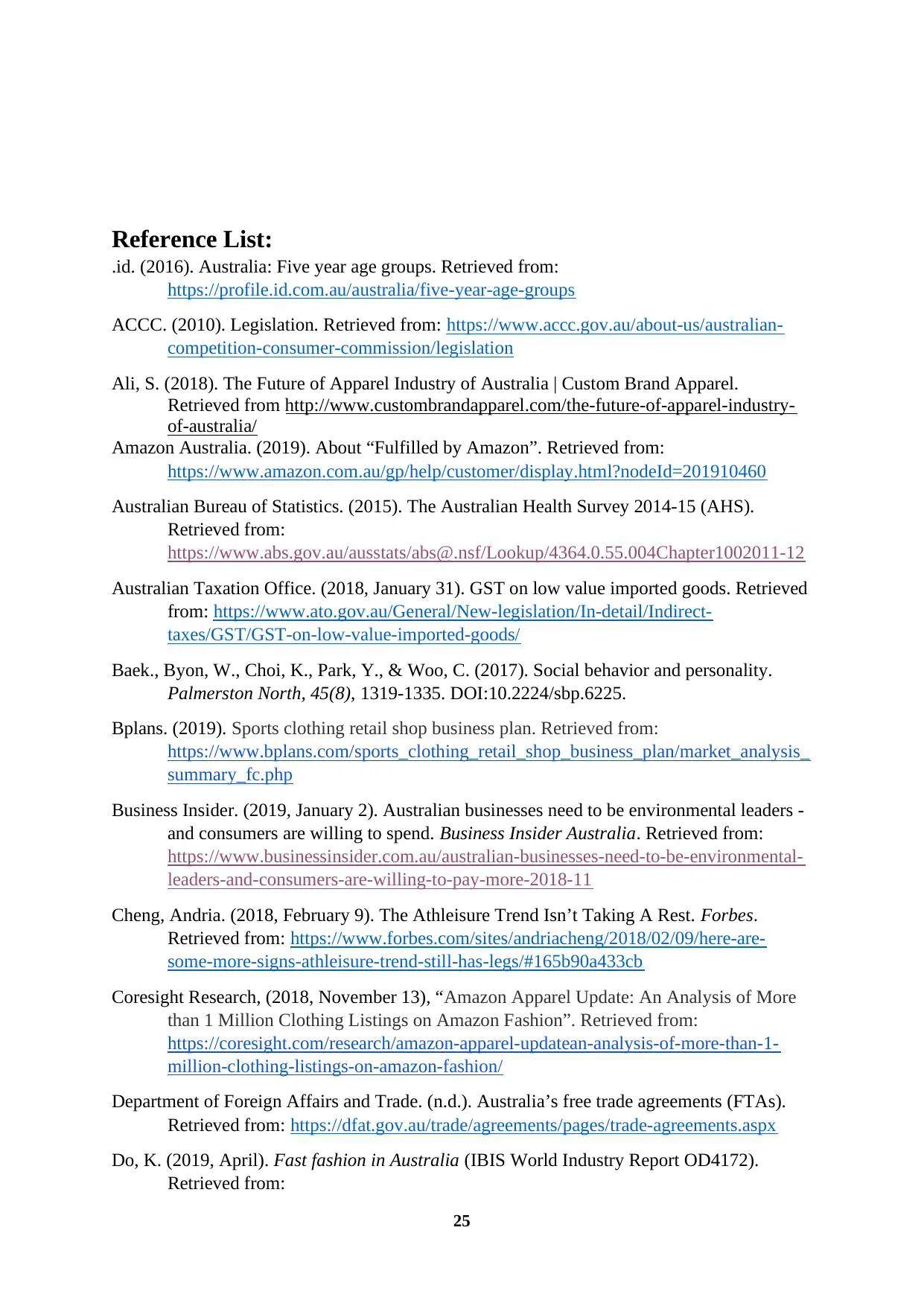
25
Reference List:
.id. (2016). Australia: Five year age groups. Retrieved from:
https://profile.id.com.au/australia/five-year-age-groups
ACCC. (2010). Legislation. Retrieved from: https://www.accc.gov.au/about-us/australian-
competition-consumer-commission/legislation
Ali, S. (2018). The Future of Apparel Industry of Australia | Custom Brand Apparel.
Retrieved from http://www.custombrandapparel.com/the-future-of-apparel-industry-
of-australia/
Amazon Australia. (2019). About “Fulfilled by Amazon”. Retrieved from:
https://www.amazon.com.au/gp/help/customer/display.html?nodeId=201910460
Australian Bureau of Statistics. (2015). The Australian Health Survey 2014-15 (AHS).
Retrieved from:
https://www.abs.gov.au/ausstats/abs@.nsf/Lookup/4364.0.55.004Chapter1002011-12
Australian Taxation Office. (2018, January 31). GST on low value imported goods. Retrieved
from: https://www.ato.gov.au/General/New-legislation/In-detail/Indirect-
taxes/GST/GST-on-low-value-imported-goods/
Baek., Byon, W., Choi, K., Park, Y., & Woo, C. (2017). Social behavior and personality.
Palmerston North, 45(8), 1319-1335. DOI:10.2224/sbp.6225.
Bplans. (2019). Sports clothing retail shop business plan. Retrieved from:
https://www.bplans.com/sports_clothing_retail_shop_business_plan/market_analysis_
summary_fc.php
Business Insider. (2019, January 2). Australian businesses need to be environmental leaders -
and consumers are willing to spend. Business Insider Australia. Retrieved from:
https://www.businessinsider.com.au/australian-businesses-need-to-be-environmental-
leaders-and-consumers-are-willing-to-pay-more-2018-11
Cheng, Andria. (2018, February 9). The Athleisure Trend Isn’t Taking A Rest. Forbes.
Retrieved from: https://www.forbes.com/sites/andriacheng/2018/02/09/here-are-
some-more-signs-athleisure-trend-still-has-legs/#165b90a433cb
Coresight Research, (2018, November 13), “Amazon Apparel Update: An Analysis of More
than 1 Million Clothing Listings on Amazon Fashion”. Retrieved from:
https://coresight.com/research/amazon-apparel-updatean-analysis-of-more-than-1-
million-clothing-listings-on-amazon-fashion/
Department of Foreign Affairs and Trade. (n.d.). Australia’s free trade agreements (FTAs).
Retrieved from: https://dfat.gov.au/trade/agreements/pages/trade-agreements.aspx
Do, K. (2019, April). Fast fashion in Australia (IBIS World Industry Report OD4172).
Retrieved from:
Reference List:
.id. (2016). Australia: Five year age groups. Retrieved from:
https://profile.id.com.au/australia/five-year-age-groups
ACCC. (2010). Legislation. Retrieved from: https://www.accc.gov.au/about-us/australian-
competition-consumer-commission/legislation
Ali, S. (2018). The Future of Apparel Industry of Australia | Custom Brand Apparel.
Retrieved from http://www.custombrandapparel.com/the-future-of-apparel-industry-
of-australia/
Amazon Australia. (2019). About “Fulfilled by Amazon”. Retrieved from:
https://www.amazon.com.au/gp/help/customer/display.html?nodeId=201910460
Australian Bureau of Statistics. (2015). The Australian Health Survey 2014-15 (AHS).
Retrieved from:
https://www.abs.gov.au/ausstats/abs@.nsf/Lookup/4364.0.55.004Chapter1002011-12
Australian Taxation Office. (2018, January 31). GST on low value imported goods. Retrieved
from: https://www.ato.gov.au/General/New-legislation/In-detail/Indirect-
taxes/GST/GST-on-low-value-imported-goods/
Baek., Byon, W., Choi, K., Park, Y., & Woo, C. (2017). Social behavior and personality.
Palmerston North, 45(8), 1319-1335. DOI:10.2224/sbp.6225.
Bplans. (2019). Sports clothing retail shop business plan. Retrieved from:
https://www.bplans.com/sports_clothing_retail_shop_business_plan/market_analysis_
summary_fc.php
Business Insider. (2019, January 2). Australian businesses need to be environmental leaders -
and consumers are willing to spend. Business Insider Australia. Retrieved from:
https://www.businessinsider.com.au/australian-businesses-need-to-be-environmental-
leaders-and-consumers-are-willing-to-pay-more-2018-11
Cheng, Andria. (2018, February 9). The Athleisure Trend Isn’t Taking A Rest. Forbes.
Retrieved from: https://www.forbes.com/sites/andriacheng/2018/02/09/here-are-
some-more-signs-athleisure-trend-still-has-legs/#165b90a433cb
Coresight Research, (2018, November 13), “Amazon Apparel Update: An Analysis of More
than 1 Million Clothing Listings on Amazon Fashion”. Retrieved from:
https://coresight.com/research/amazon-apparel-updatean-analysis-of-more-than-1-
million-clothing-listings-on-amazon-fashion/
Department of Foreign Affairs and Trade. (n.d.). Australia’s free trade agreements (FTAs).
Retrieved from: https://dfat.gov.au/trade/agreements/pages/trade-agreements.aspx
Do, K. (2019, April). Fast fashion in Australia (IBIS World Industry Report OD4172).
Retrieved from:
Paraphrase This Document
Need a fresh take? Get an instant paraphrase of this document with our AI Paraphraser
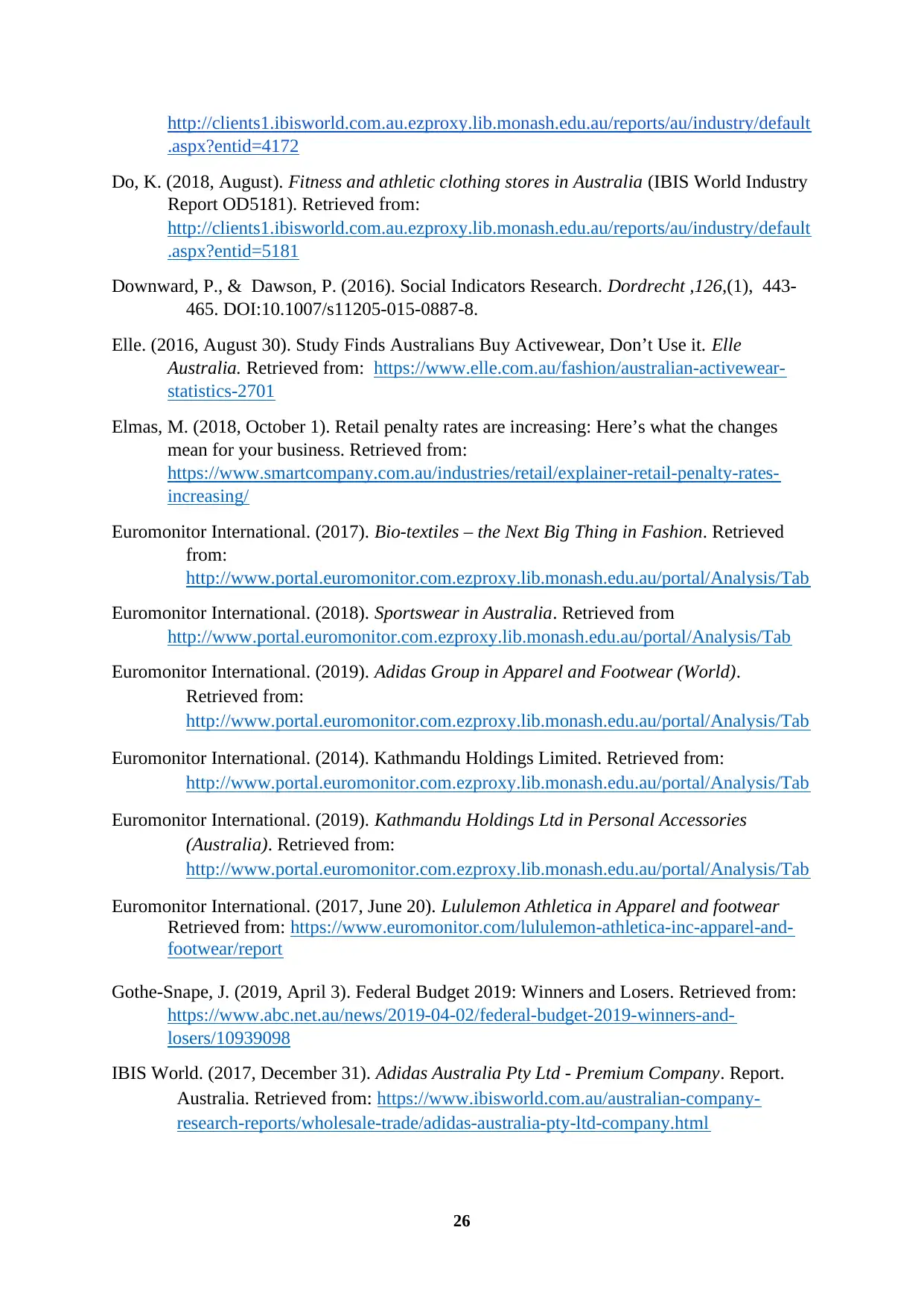
26
http://clients1.ibisworld.com.au.ezproxy.lib.monash.edu.au/reports/au/industry/default
.aspx?entid=4172
Do, K. (2018, August). Fitness and athletic clothing stores in Australia (IBIS World Industry
Report OD5181). Retrieved from:
http://clients1.ibisworld.com.au.ezproxy.lib.monash.edu.au/reports/au/industry/default
.aspx?entid=5181
Downward, P., & Dawson, P. (2016). Social Indicators Research. Dordrecht ,126,(1), 443-
465. DOI:10.1007/s11205-015-0887-8.
Elle. (2016, August 30). Study Finds Australians Buy Activewear, Don’t Use it. Elle
Australia. Retrieved from: https://www.elle.com.au/fashion/australian-activewear-
statistics-2701
Elmas, M. (2018, October 1). Retail penalty rates are increasing: Here’s what the changes
mean for your business. Retrieved from:
https://www.smartcompany.com.au/industries/retail/explainer-retail-penalty-rates-
increasing/
Euromonitor International. (2017). Bio-textiles – the Next Big Thing in Fashion. Retrieved
from:
http://www.portal.euromonitor.com.ezproxy.lib.monash.edu.au/portal/Analysis/Tab
Euromonitor International. (2018). Sportswear in Australia. Retrieved from
http://www.portal.euromonitor.com.ezproxy.lib.monash.edu.au/portal/Analysis/Tab
Euromonitor International. (2019). Adidas Group in Apparel and Footwear (World).
Retrieved from:
http://www.portal.euromonitor.com.ezproxy.lib.monash.edu.au/portal/Analysis/Tab
Euromonitor International. (2014). Kathmandu Holdings Limited. Retrieved from:
http://www.portal.euromonitor.com.ezproxy.lib.monash.edu.au/portal/Analysis/Tab
Euromonitor International. (2019). Kathmandu Holdings Ltd in Personal Accessories
(Australia). Retrieved from:
http://www.portal.euromonitor.com.ezproxy.lib.monash.edu.au/portal/Analysis/Tab
Euromonitor International. (2017, June 20). Lululemon Athletica in Apparel and footwear
Retrieved from: https://www.euromonitor.com/lululemon-athletica-inc-apparel-and-
footwear/report
Gothe-Snape, J. (2019, April 3). Federal Budget 2019: Winners and Losers. Retrieved from:
https://www.abc.net.au/news/2019-04-02/federal-budget-2019-winners-and-
losers/10939098
IBIS World. (2017, December 31). Adidas Australia Pty Ltd - Premium Company. Report.
Australia. Retrieved from: https://www.ibisworld.com.au/australian-company-
research-reports/wholesale-trade/adidas-australia-pty-ltd-company.html
http://clients1.ibisworld.com.au.ezproxy.lib.monash.edu.au/reports/au/industry/default
.aspx?entid=4172
Do, K. (2018, August). Fitness and athletic clothing stores in Australia (IBIS World Industry
Report OD5181). Retrieved from:
http://clients1.ibisworld.com.au.ezproxy.lib.monash.edu.au/reports/au/industry/default
.aspx?entid=5181
Downward, P., & Dawson, P. (2016). Social Indicators Research. Dordrecht ,126,(1), 443-
465. DOI:10.1007/s11205-015-0887-8.
Elle. (2016, August 30). Study Finds Australians Buy Activewear, Don’t Use it. Elle
Australia. Retrieved from: https://www.elle.com.au/fashion/australian-activewear-
statistics-2701
Elmas, M. (2018, October 1). Retail penalty rates are increasing: Here’s what the changes
mean for your business. Retrieved from:
https://www.smartcompany.com.au/industries/retail/explainer-retail-penalty-rates-
increasing/
Euromonitor International. (2017). Bio-textiles – the Next Big Thing in Fashion. Retrieved
from:
http://www.portal.euromonitor.com.ezproxy.lib.monash.edu.au/portal/Analysis/Tab
Euromonitor International. (2018). Sportswear in Australia. Retrieved from
http://www.portal.euromonitor.com.ezproxy.lib.monash.edu.au/portal/Analysis/Tab
Euromonitor International. (2019). Adidas Group in Apparel and Footwear (World).
Retrieved from:
http://www.portal.euromonitor.com.ezproxy.lib.monash.edu.au/portal/Analysis/Tab
Euromonitor International. (2014). Kathmandu Holdings Limited. Retrieved from:
http://www.portal.euromonitor.com.ezproxy.lib.monash.edu.au/portal/Analysis/Tab
Euromonitor International. (2019). Kathmandu Holdings Ltd in Personal Accessories
(Australia). Retrieved from:
http://www.portal.euromonitor.com.ezproxy.lib.monash.edu.au/portal/Analysis/Tab
Euromonitor International. (2017, June 20). Lululemon Athletica in Apparel and footwear
Retrieved from: https://www.euromonitor.com/lululemon-athletica-inc-apparel-and-
footwear/report
Gothe-Snape, J. (2019, April 3). Federal Budget 2019: Winners and Losers. Retrieved from:
https://www.abc.net.au/news/2019-04-02/federal-budget-2019-winners-and-
losers/10939098
IBIS World. (2017, December 31). Adidas Australia Pty Ltd - Premium Company. Report.
Australia. Retrieved from: https://www.ibisworld.com.au/australian-company-
research-reports/wholesale-trade/adidas-australia-pty-ltd-company.html
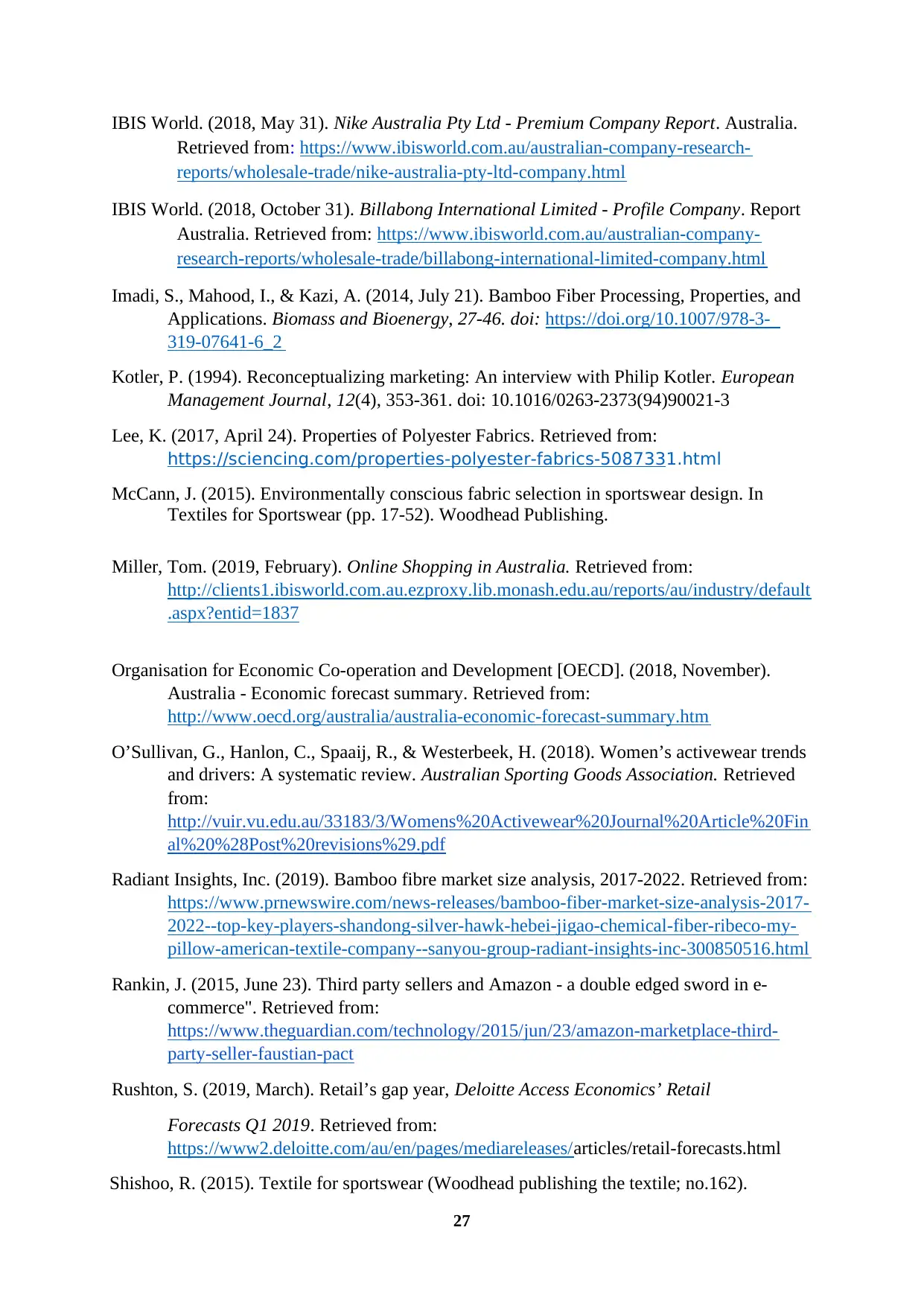
27
IBIS World. (2018, May 31). Nike Australia Pty Ltd - Premium Company Report. Australia.
Retrieved from: https://www.ibisworld.com.au/australian-company-research-
reports/wholesale-trade/nike-australia-pty-ltd-company.html
IBIS World. (2018, October 31). Billabong International Limited - Profile Company. Report
Australia. Retrieved from: https://www.ibisworld.com.au/australian-company-
research-reports/wholesale-trade/billabong-international-limited-company.html
Imadi, S., Mahood, I., & Kazi, A. (2014, July 21). Bamboo Fiber Processing, Properties, and
Applications. Biomass and Bioenergy, 27-46. doi: https://doi.org/10.1007/978-3-
319-07641-6_2
Kotler, P. (1994). Reconceptualizing marketing: An interview with Philip Kotler. European
Management Journal, 12(4), 353-361. doi: 10.1016/0263-2373(94)90021-3
Lee, K. (2017, April 24). Properties of Polyester Fabrics. Retrieved from:
https://sciencing.com/properties-polyester-fabrics-5087331.html
McCann, J. (2015). Environmentally conscious fabric selection in sportswear design. In
Textiles for Sportswear (pp. 17-52). Woodhead Publishing.
Miller, Tom. (2019, February). Online Shopping in Australia. Retrieved from:
http://clients1.ibisworld.com.au.ezproxy.lib.monash.edu.au/reports/au/industry/default
.aspx?entid=1837
Organisation for Economic Co-operation and Development [OECD]. (2018, November).
Australia - Economic forecast summary. Retrieved from:
http://www.oecd.org/australia/australia-economic-forecast-summary.htm
O’Sullivan, G., Hanlon, C., Spaaij, R., & Westerbeek, H. (2018). Women’s activewear trends
and drivers: A systematic review. Australian Sporting Goods Association. Retrieved
from:
http://vuir.vu.edu.au/33183/3/Womens%20Activewear%20Journal%20Article%20Fin
al%20%28Post%20revisions%29.pdf
Radiant Insights, Inc. (2019). Bamboo fibre market size analysis, 2017-2022. Retrieved from:
https://www.prnewswire.com/news-releases/bamboo-fiber-market-size-analysis-2017-
2022--top-key-players-shandong-silver-hawk-hebei-jigao-chemical-fiber-ribeco-my-
pillow-american-textile-company--sanyou-group-radiant-insights-inc-300850516.html
Rankin, J. (2015, June 23). Third party sellers and Amazon - a double edged sword in e-
commerce". Retrieved from:
https://www.theguardian.com/technology/2015/jun/23/amazon-marketplace-third-
party-seller-faustian-pact
Rushton, S. (2019, March). Retail’s gap year, Deloitte Access Economics’ Retail
Forecasts Q1 2019. Retrieved from:
https://www2.deloitte.com/au/en/pages/mediareleases/articles/retail-forecasts.html
Shishoo, R. (2015). Textile for sportswear (Woodhead publishing the textile; no.162).
IBIS World. (2018, May 31). Nike Australia Pty Ltd - Premium Company Report. Australia.
Retrieved from: https://www.ibisworld.com.au/australian-company-research-
reports/wholesale-trade/nike-australia-pty-ltd-company.html
IBIS World. (2018, October 31). Billabong International Limited - Profile Company. Report
Australia. Retrieved from: https://www.ibisworld.com.au/australian-company-
research-reports/wholesale-trade/billabong-international-limited-company.html
Imadi, S., Mahood, I., & Kazi, A. (2014, July 21). Bamboo Fiber Processing, Properties, and
Applications. Biomass and Bioenergy, 27-46. doi: https://doi.org/10.1007/978-3-
319-07641-6_2
Kotler, P. (1994). Reconceptualizing marketing: An interview with Philip Kotler. European
Management Journal, 12(4), 353-361. doi: 10.1016/0263-2373(94)90021-3
Lee, K. (2017, April 24). Properties of Polyester Fabrics. Retrieved from:
https://sciencing.com/properties-polyester-fabrics-5087331.html
McCann, J. (2015). Environmentally conscious fabric selection in sportswear design. In
Textiles for Sportswear (pp. 17-52). Woodhead Publishing.
Miller, Tom. (2019, February). Online Shopping in Australia. Retrieved from:
http://clients1.ibisworld.com.au.ezproxy.lib.monash.edu.au/reports/au/industry/default
.aspx?entid=1837
Organisation for Economic Co-operation and Development [OECD]. (2018, November).
Australia - Economic forecast summary. Retrieved from:
http://www.oecd.org/australia/australia-economic-forecast-summary.htm
O’Sullivan, G., Hanlon, C., Spaaij, R., & Westerbeek, H. (2018). Women’s activewear trends
and drivers: A systematic review. Australian Sporting Goods Association. Retrieved
from:
http://vuir.vu.edu.au/33183/3/Womens%20Activewear%20Journal%20Article%20Fin
al%20%28Post%20revisions%29.pdf
Radiant Insights, Inc. (2019). Bamboo fibre market size analysis, 2017-2022. Retrieved from:
https://www.prnewswire.com/news-releases/bamboo-fiber-market-size-analysis-2017-
2022--top-key-players-shandong-silver-hawk-hebei-jigao-chemical-fiber-ribeco-my-
pillow-american-textile-company--sanyou-group-radiant-insights-inc-300850516.html
Rankin, J. (2015, June 23). Third party sellers and Amazon - a double edged sword in e-
commerce". Retrieved from:
https://www.theguardian.com/technology/2015/jun/23/amazon-marketplace-third-
party-seller-faustian-pact
Rushton, S. (2019, March). Retail’s gap year, Deloitte Access Economics’ Retail
Forecasts Q1 2019. Retrieved from:
https://www2.deloitte.com/au/en/pages/mediareleases/articles/retail-forecasts.html
Shishoo, R. (2015). Textile for sportswear (Woodhead publishing the textile; no.162).
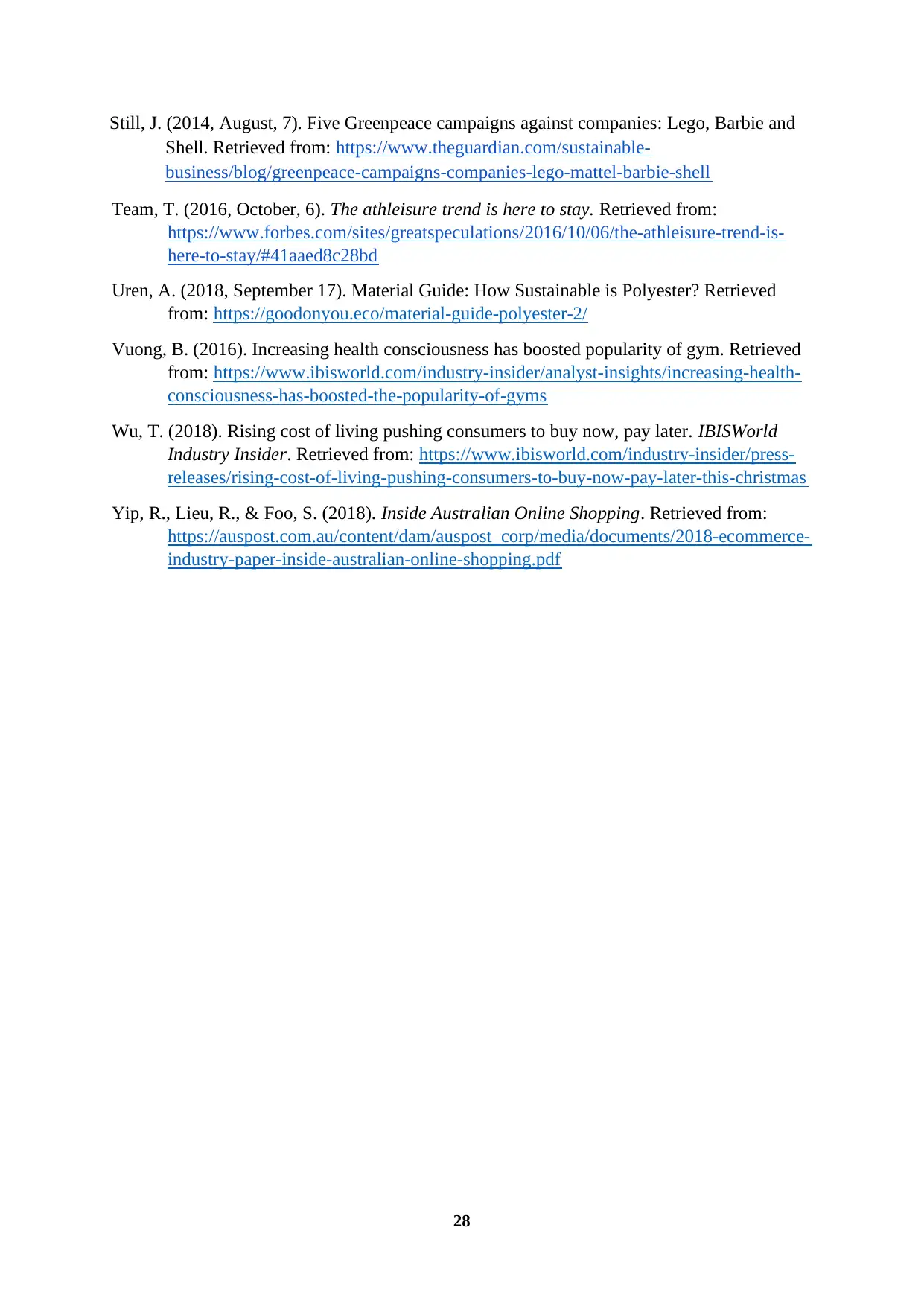
28
Still, J. (2014, August, 7). Five Greenpeace campaigns against companies: Lego, Barbie and
Shell. Retrieved from: https://www.theguardian.com/sustainable-
business/blog/greenpeace-campaigns-companies-lego-mattel-barbie-shell
Team, T. (2016, October, 6). The athleisure trend is here to stay. Retrieved from:
https://www.forbes.com/sites/greatspeculations/2016/10/06/the-athleisure-trend-is-
here-to-stay/#41aaed8c28bd
Uren, A. (2018, September 17). Material Guide: How Sustainable is Polyester? Retrieved
from: https://goodonyou.eco/material-guide-polyester-2/
Vuong, B. (2016). Increasing health consciousness has boosted popularity of gym. Retrieved
from: https://www.ibisworld.com/industry-insider/analyst-insights/increasing-health-
consciousness-has-boosted-the-popularity-of-gyms
Wu, T. (2018). Rising cost of living pushing consumers to buy now, pay later. IBISWorld
Industry Insider. Retrieved from: https://www.ibisworld.com/industry-insider/press-
releases/rising-cost-of-living-pushing-consumers-to-buy-now-pay-later-this-christmas
Yip, R., Lieu, R., & Foo, S. (2018). Inside Australian Online Shopping. Retrieved from:
https://auspost.com.au/content/dam/auspost_corp/media/documents/2018-ecommerce-
industry-paper-inside-australian-online-shopping.pdf
Still, J. (2014, August, 7). Five Greenpeace campaigns against companies: Lego, Barbie and
Shell. Retrieved from: https://www.theguardian.com/sustainable-
business/blog/greenpeace-campaigns-companies-lego-mattel-barbie-shell
Team, T. (2016, October, 6). The athleisure trend is here to stay. Retrieved from:
https://www.forbes.com/sites/greatspeculations/2016/10/06/the-athleisure-trend-is-
here-to-stay/#41aaed8c28bd
Uren, A. (2018, September 17). Material Guide: How Sustainable is Polyester? Retrieved
from: https://goodonyou.eco/material-guide-polyester-2/
Vuong, B. (2016). Increasing health consciousness has boosted popularity of gym. Retrieved
from: https://www.ibisworld.com/industry-insider/analyst-insights/increasing-health-
consciousness-has-boosted-the-popularity-of-gyms
Wu, T. (2018). Rising cost of living pushing consumers to buy now, pay later. IBISWorld
Industry Insider. Retrieved from: https://www.ibisworld.com/industry-insider/press-
releases/rising-cost-of-living-pushing-consumers-to-buy-now-pay-later-this-christmas
Yip, R., Lieu, R., & Foo, S. (2018). Inside Australian Online Shopping. Retrieved from:
https://auspost.com.au/content/dam/auspost_corp/media/documents/2018-ecommerce-
industry-paper-inside-australian-online-shopping.pdf
1 out of 28
Related Documents
Your All-in-One AI-Powered Toolkit for Academic Success.
+13062052269
info@desklib.com
Available 24*7 on WhatsApp / Email
![[object Object]](/_next/static/media/star-bottom.7253800d.svg)
Unlock your academic potential
© 2024 | Zucol Services PVT LTD | All rights reserved.





